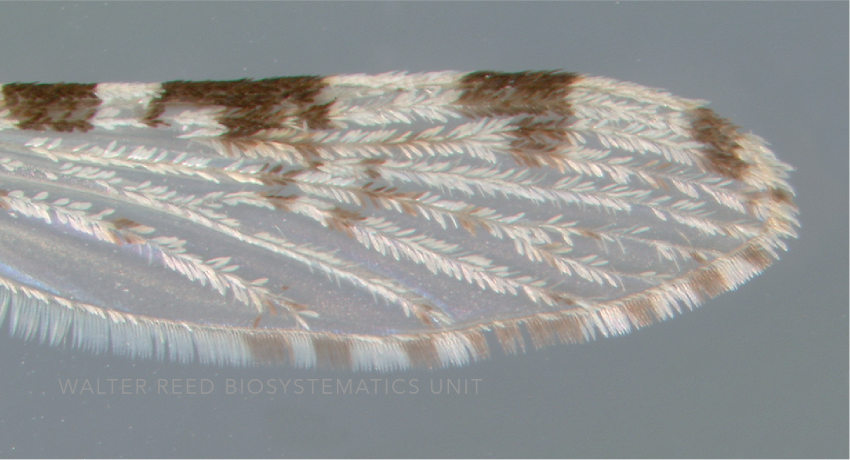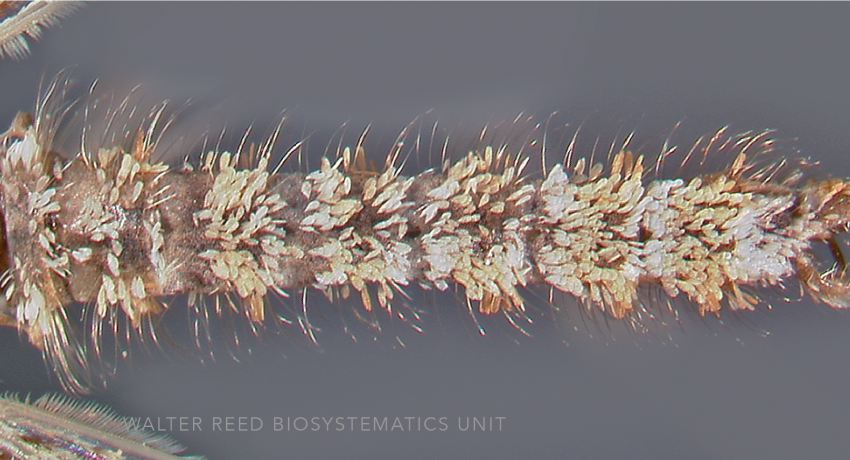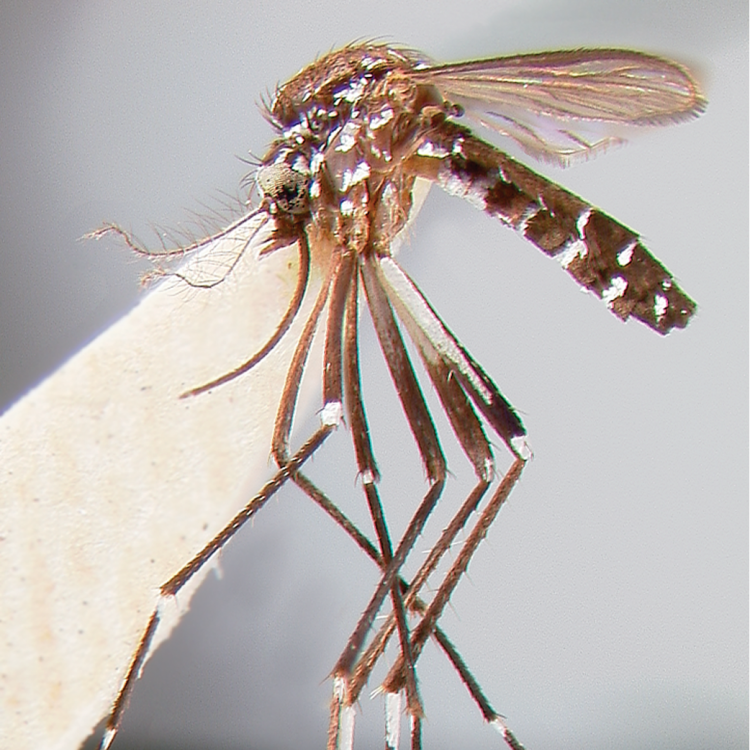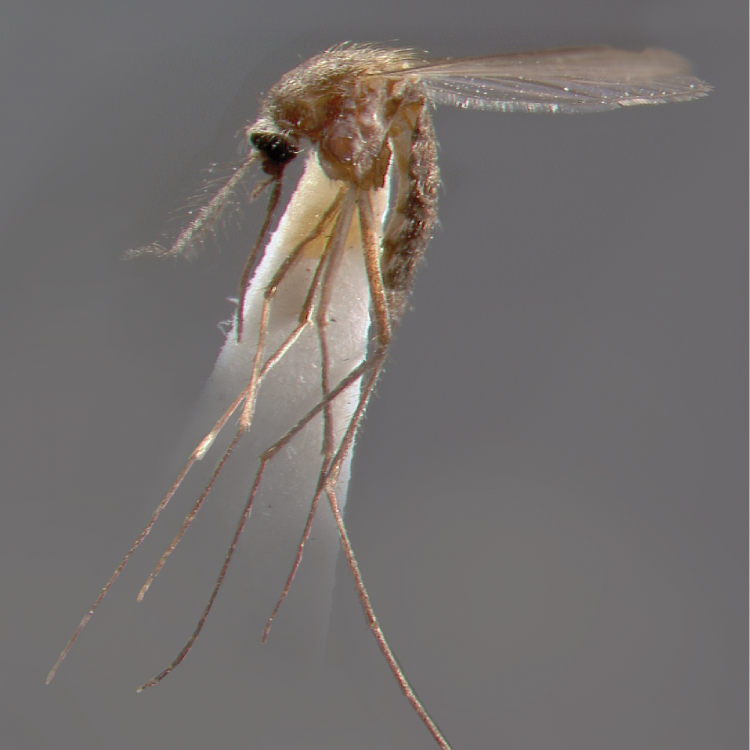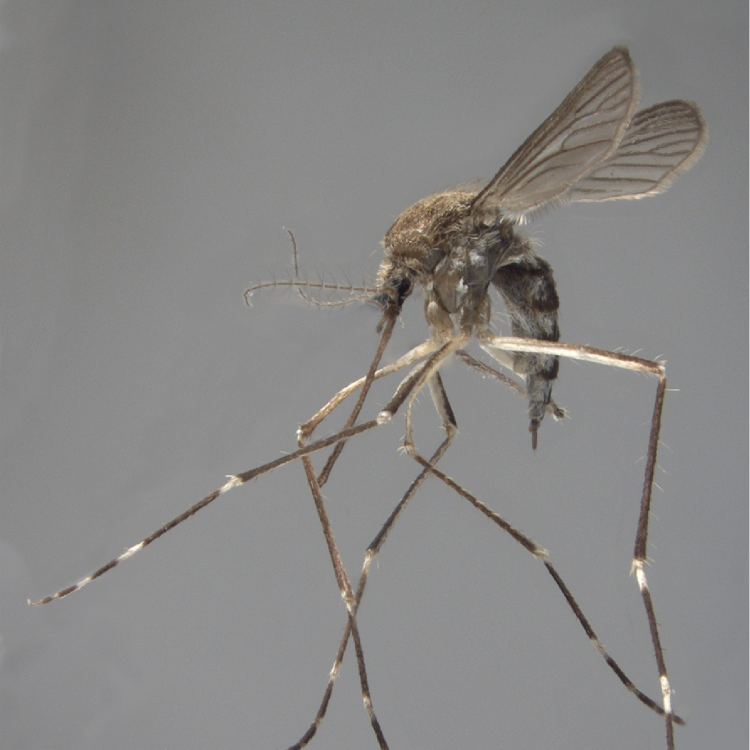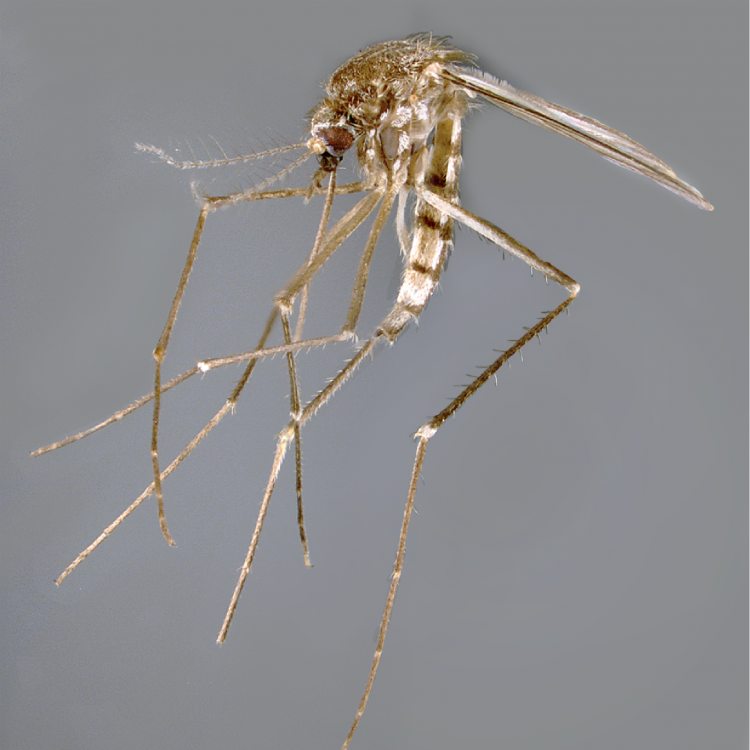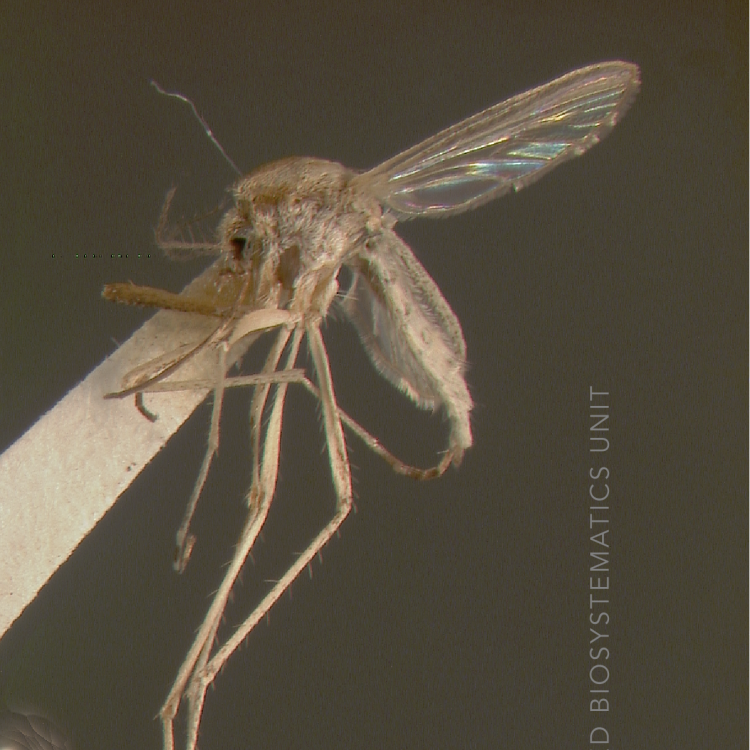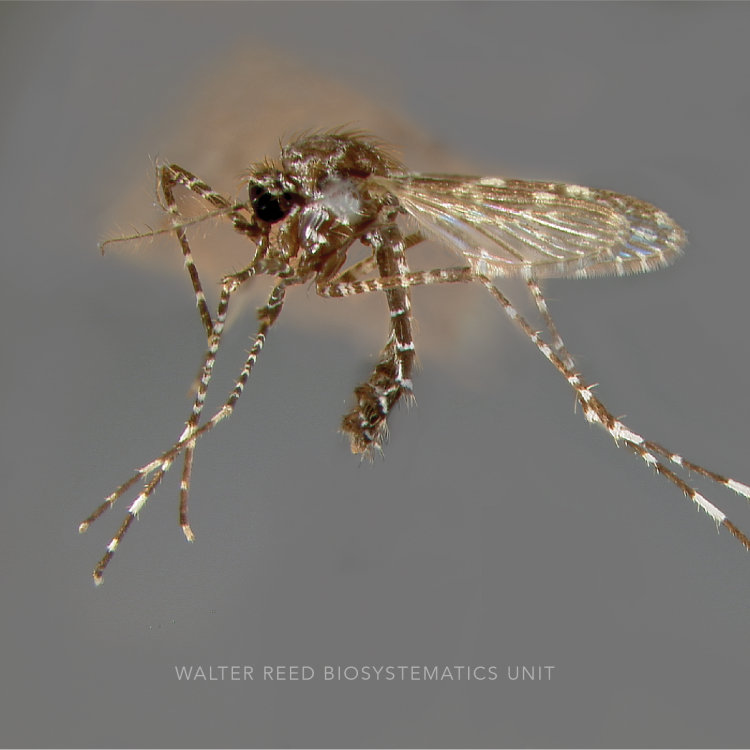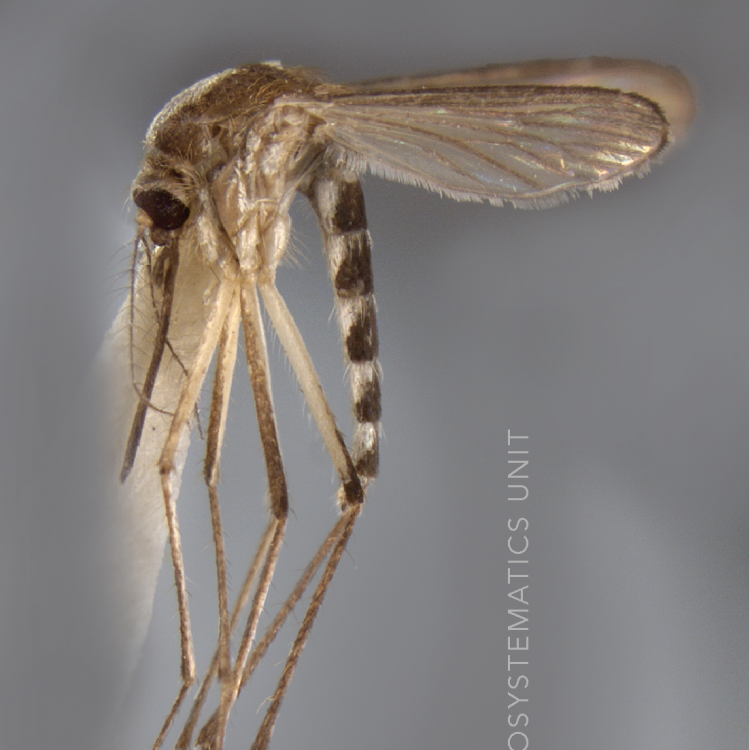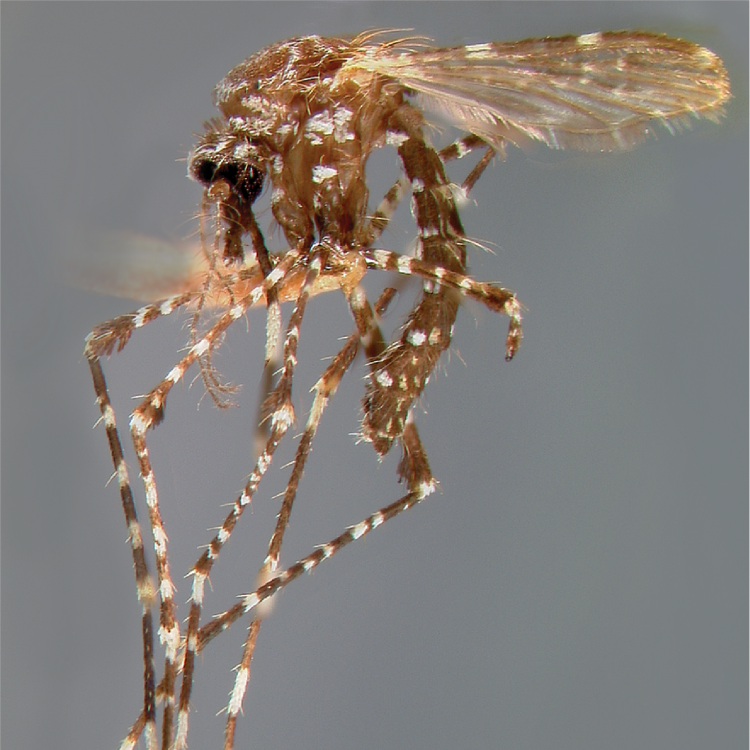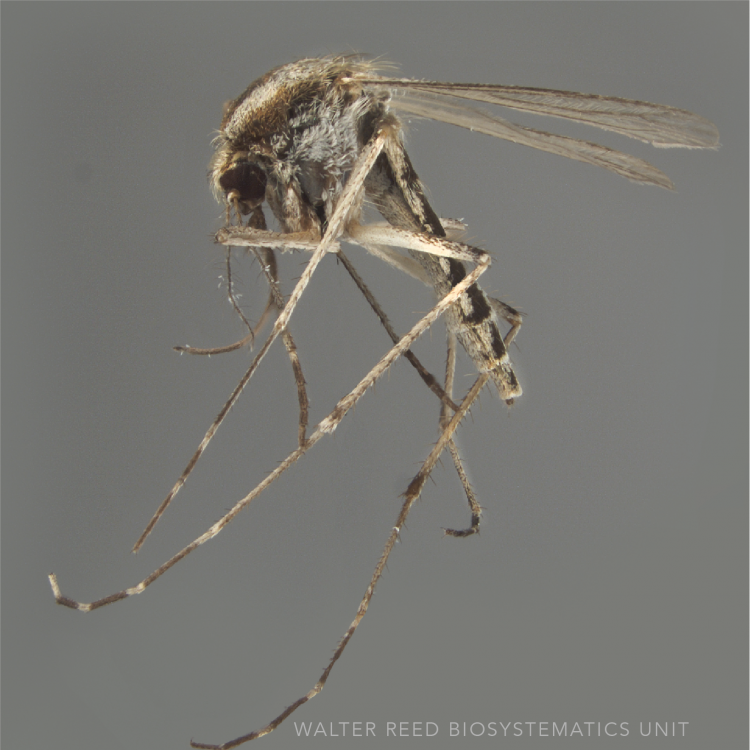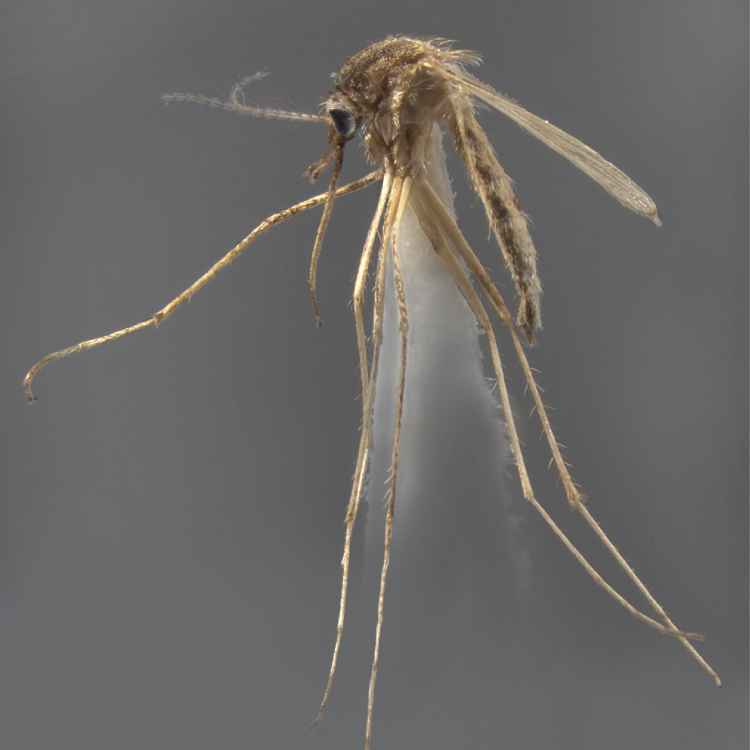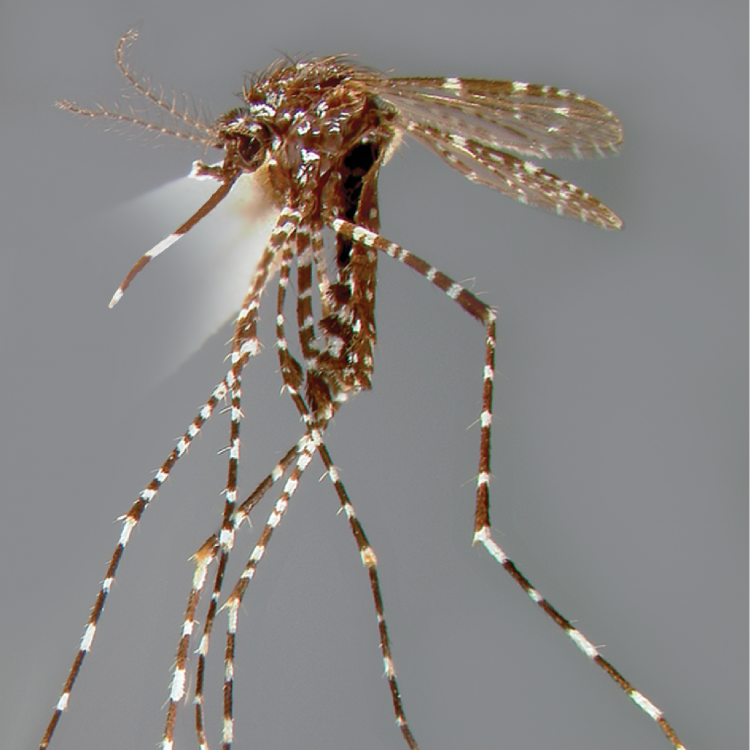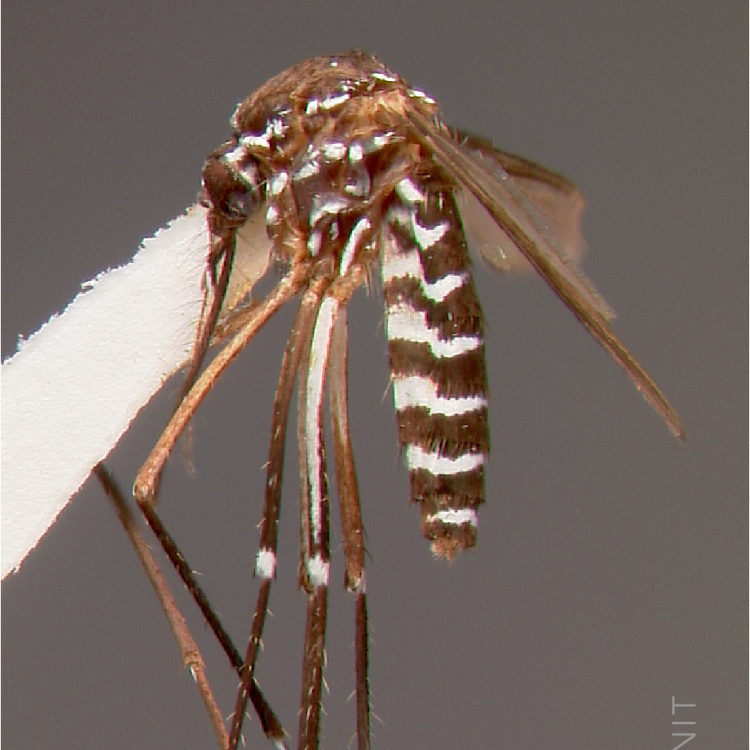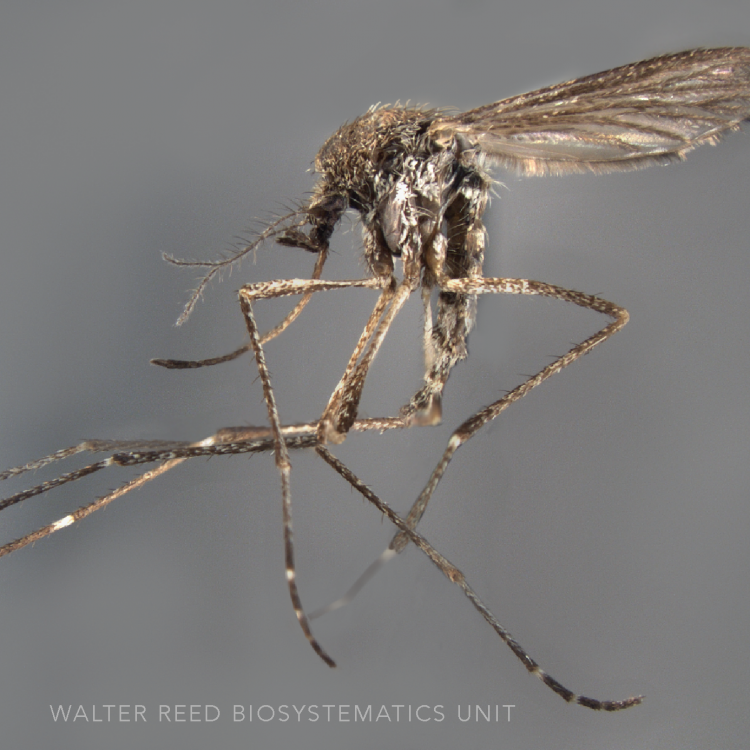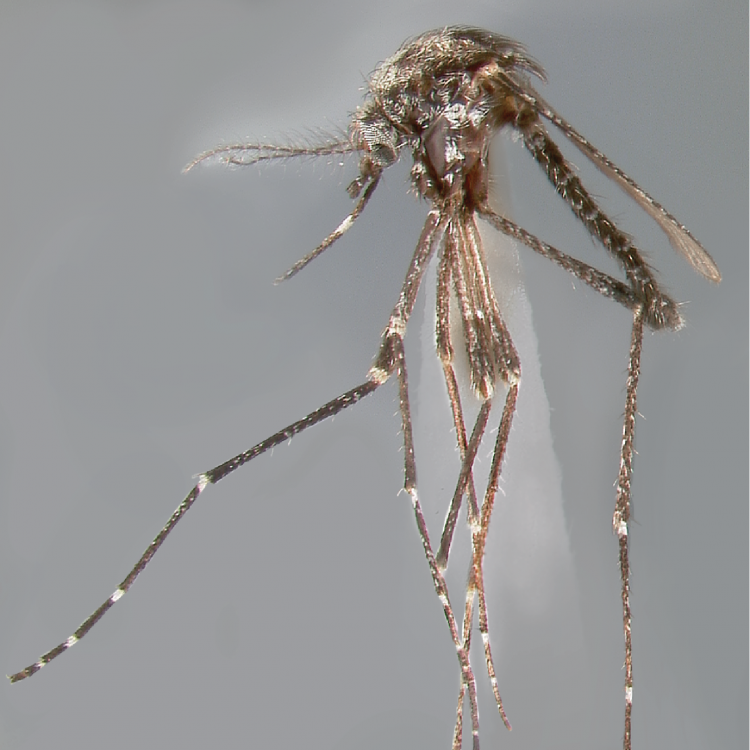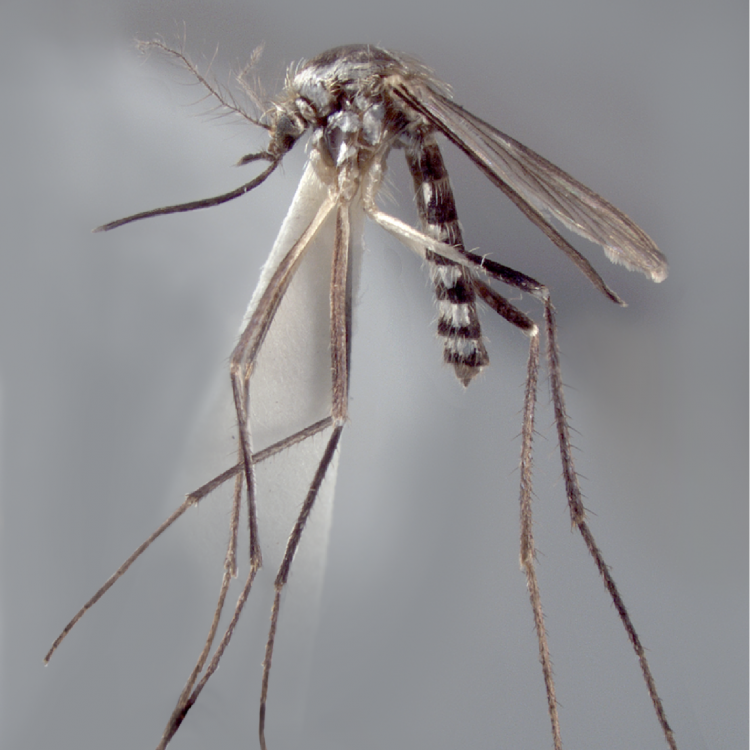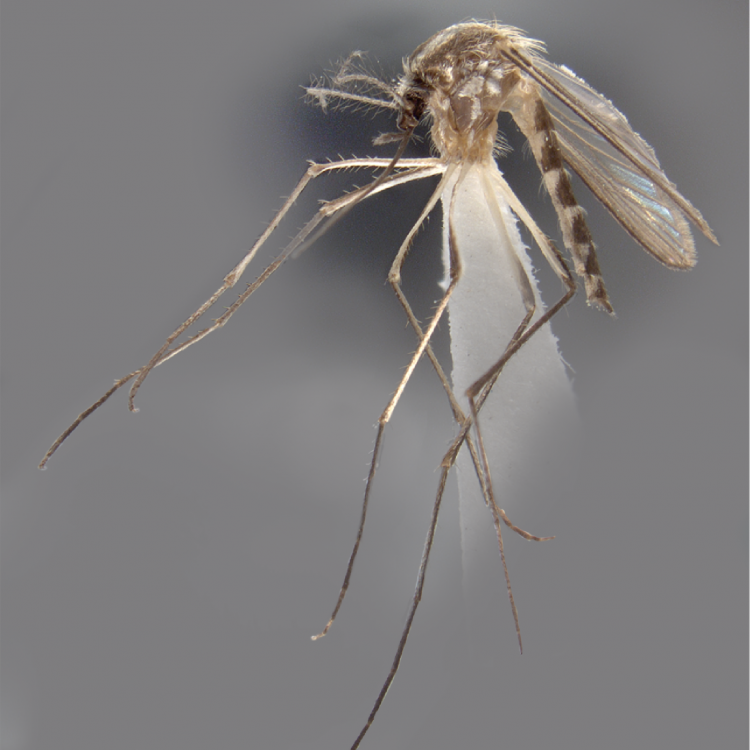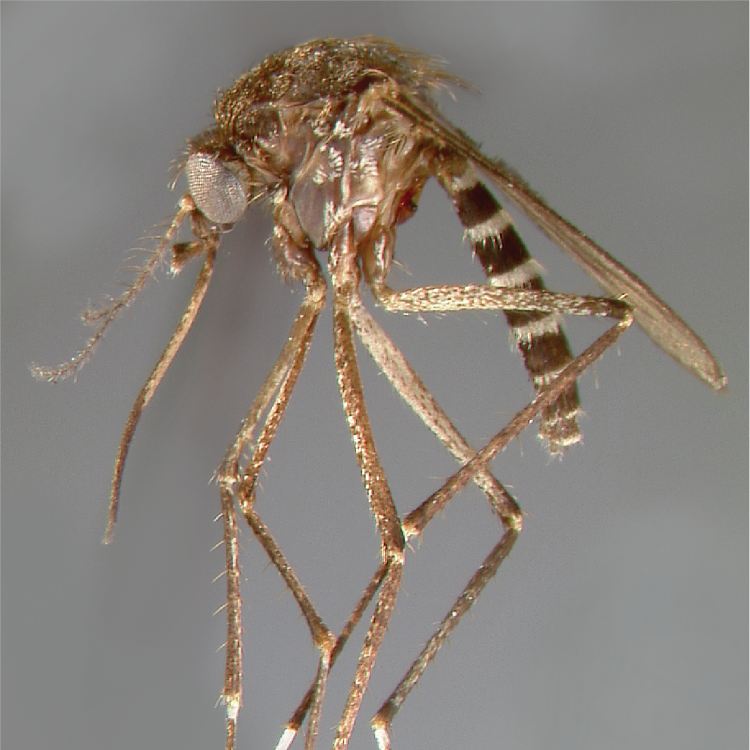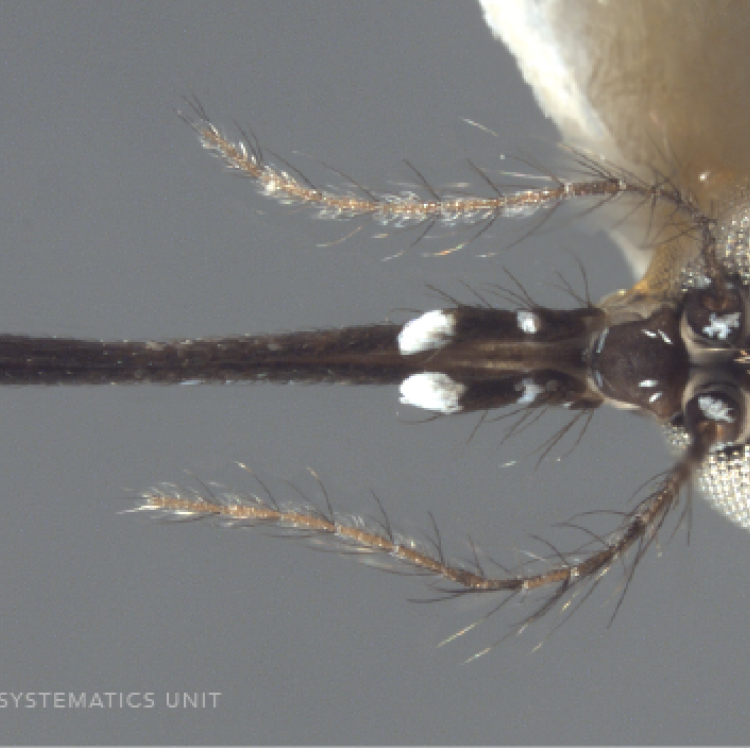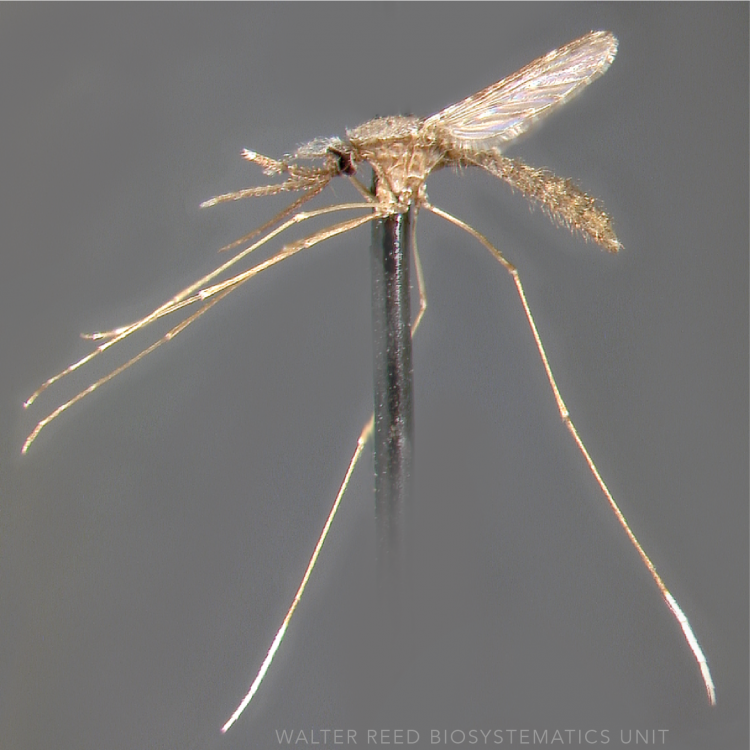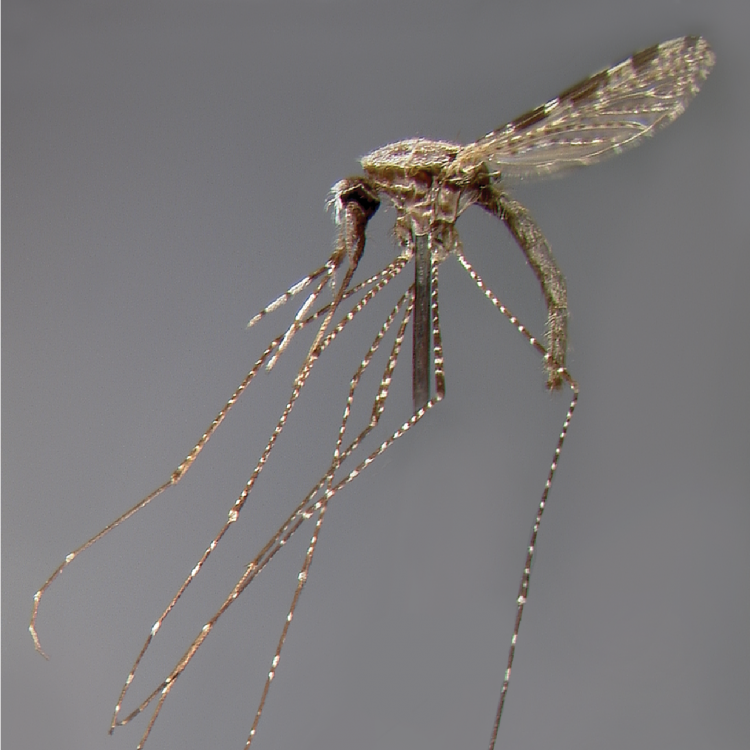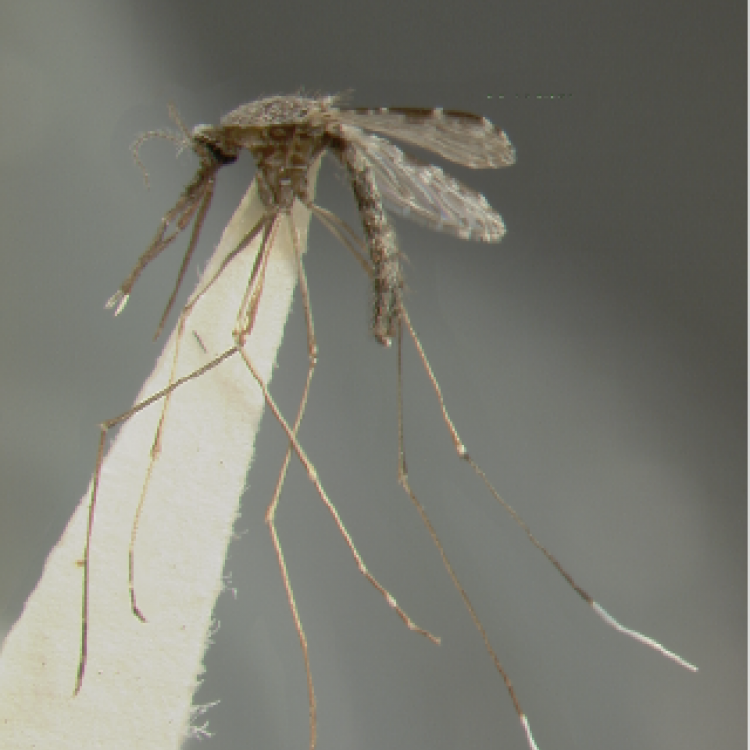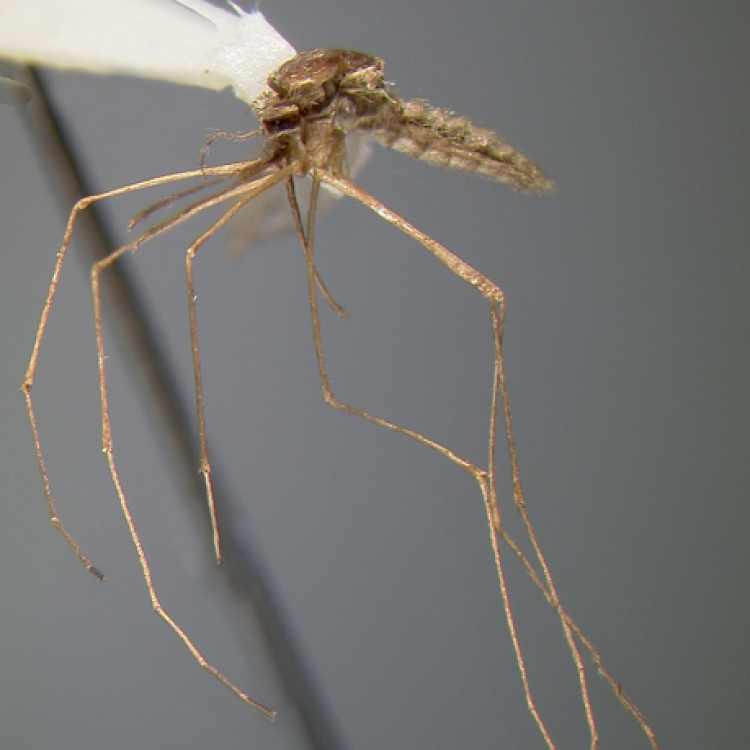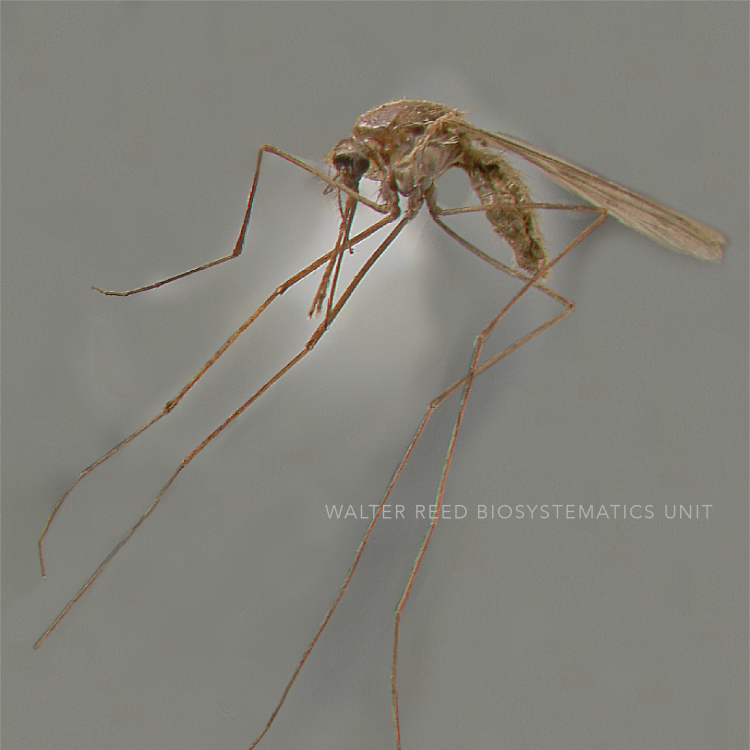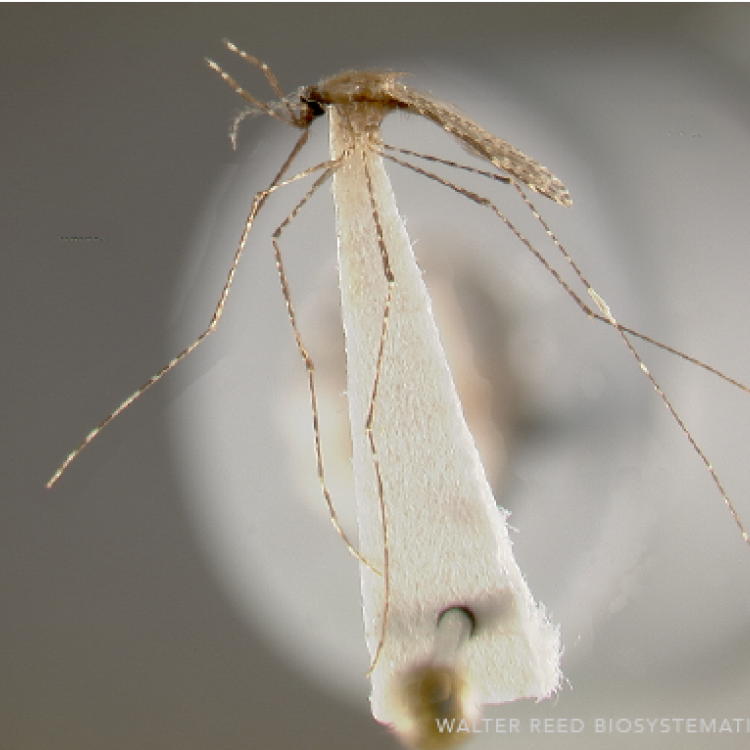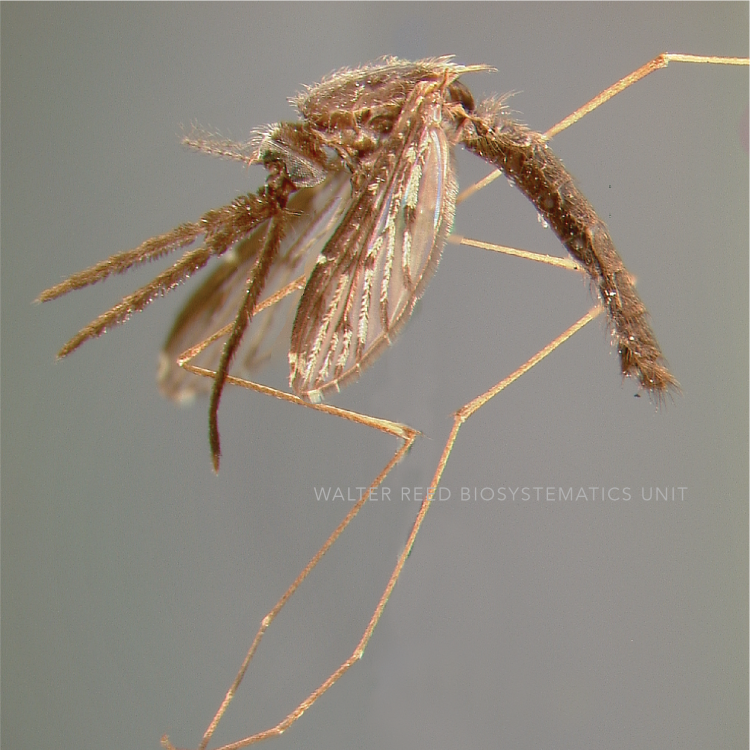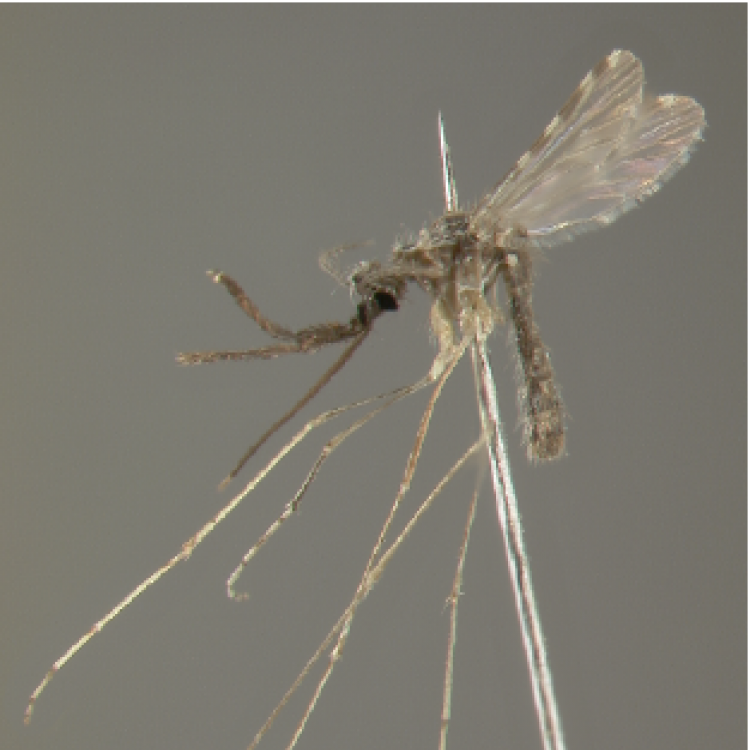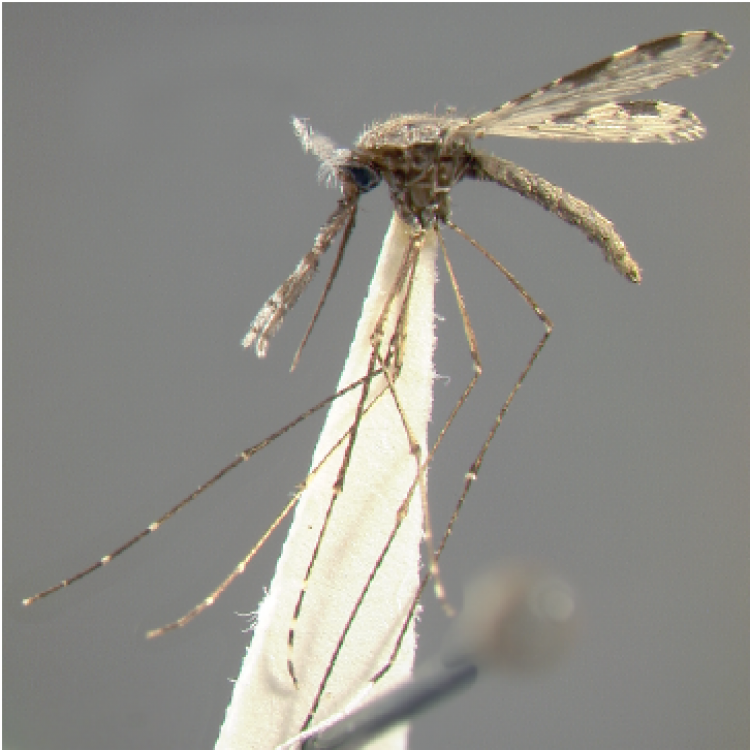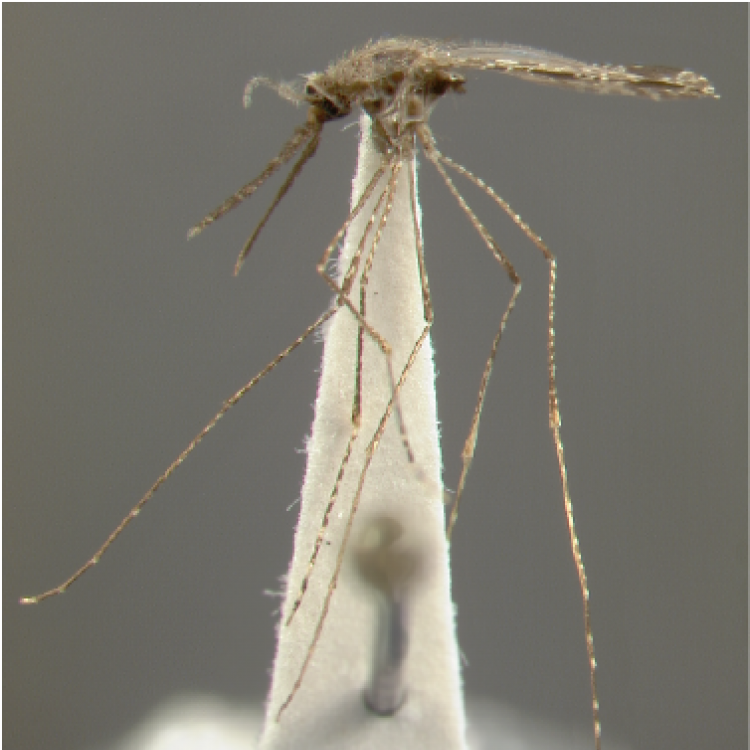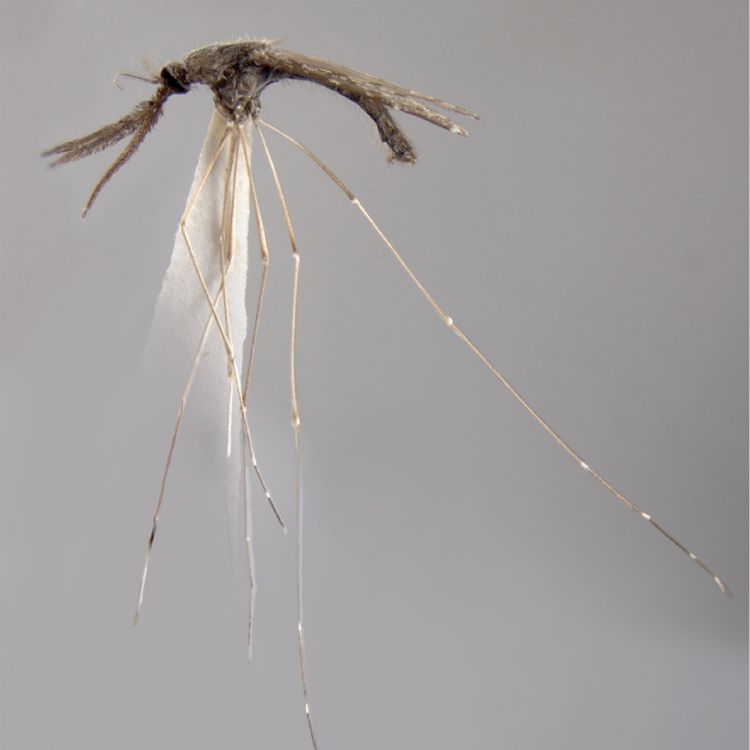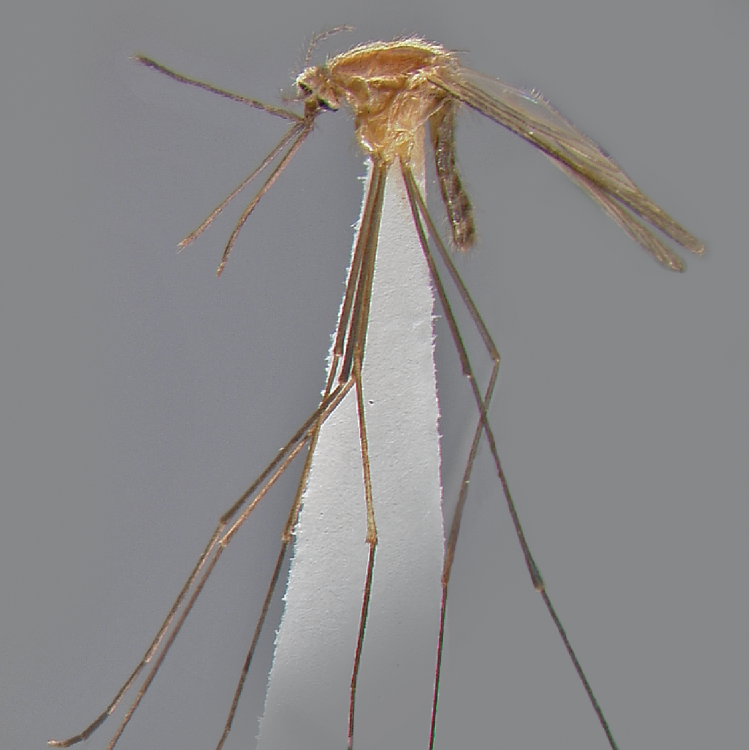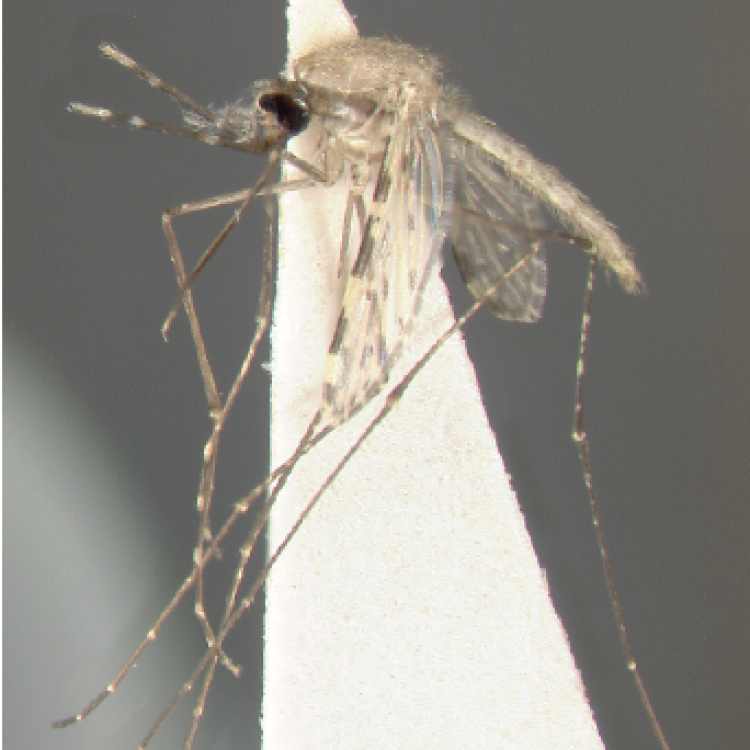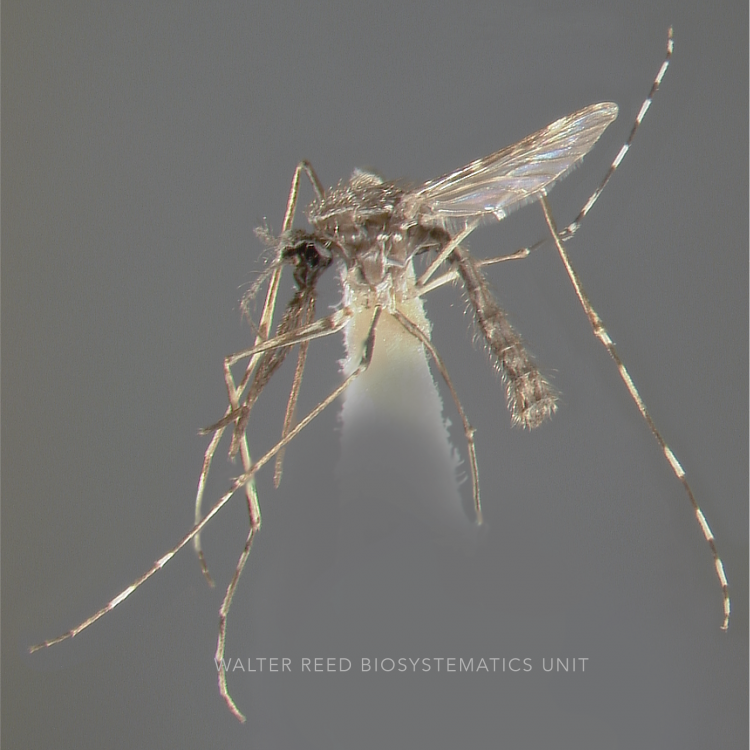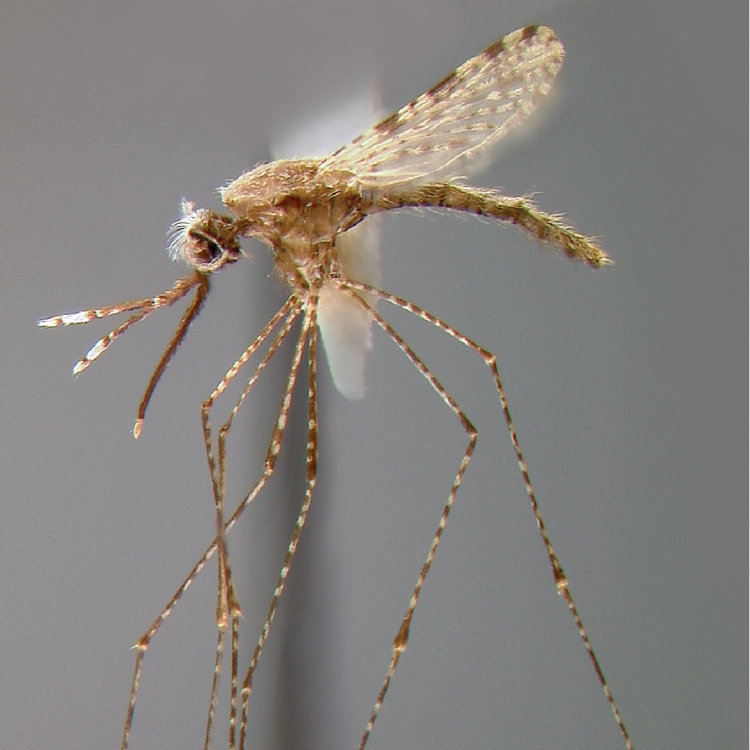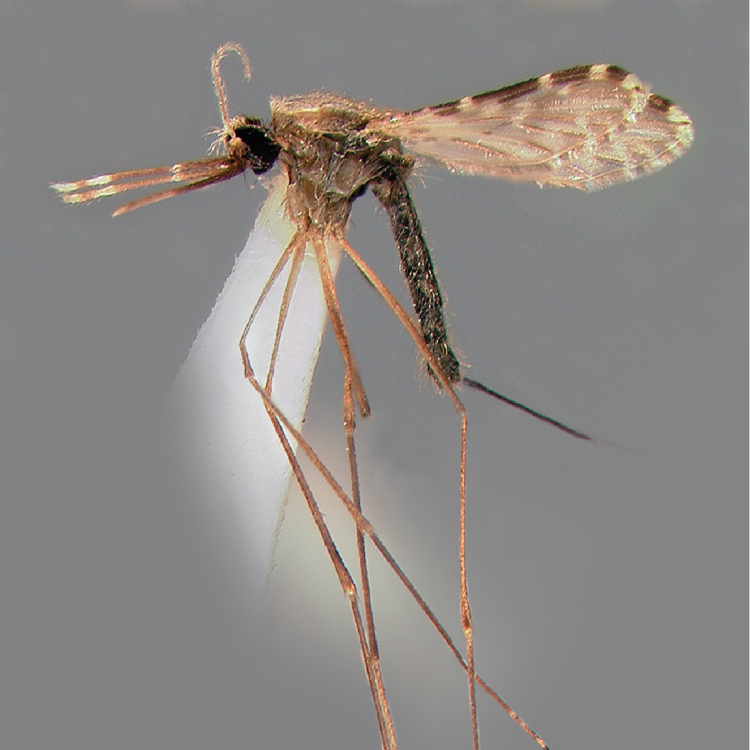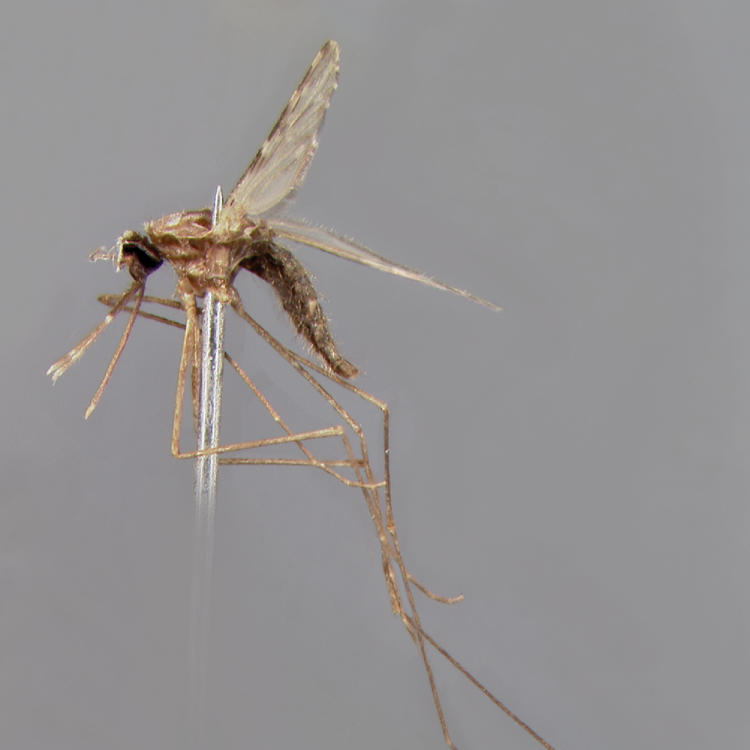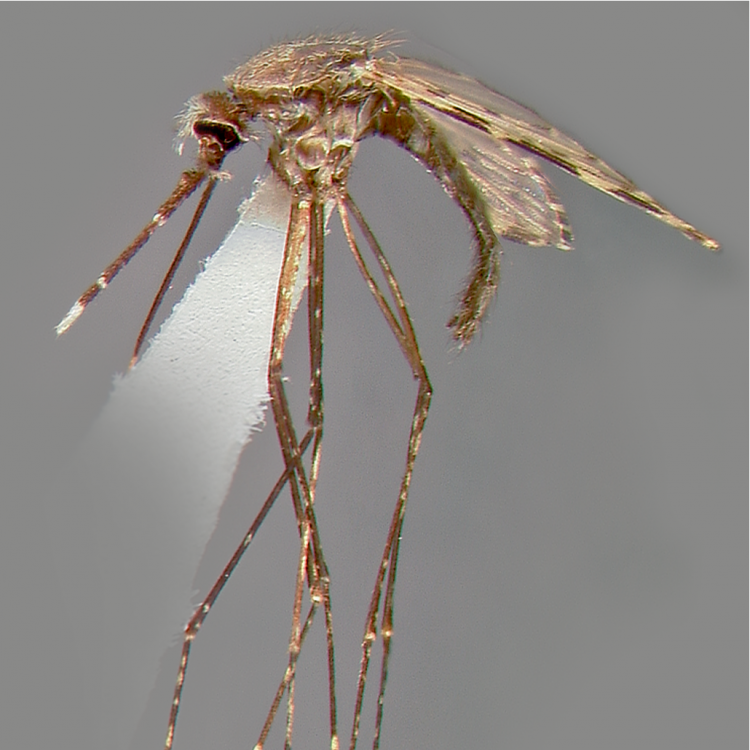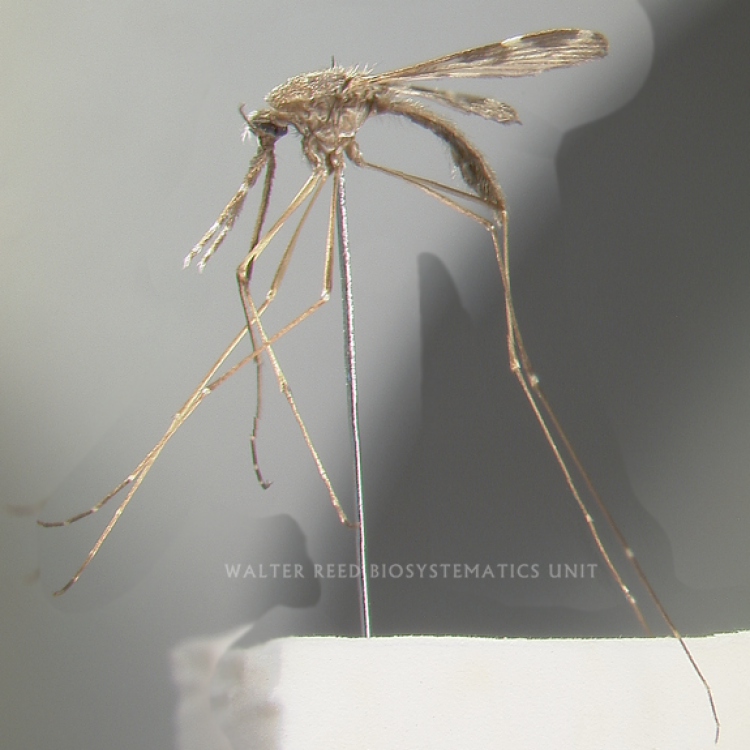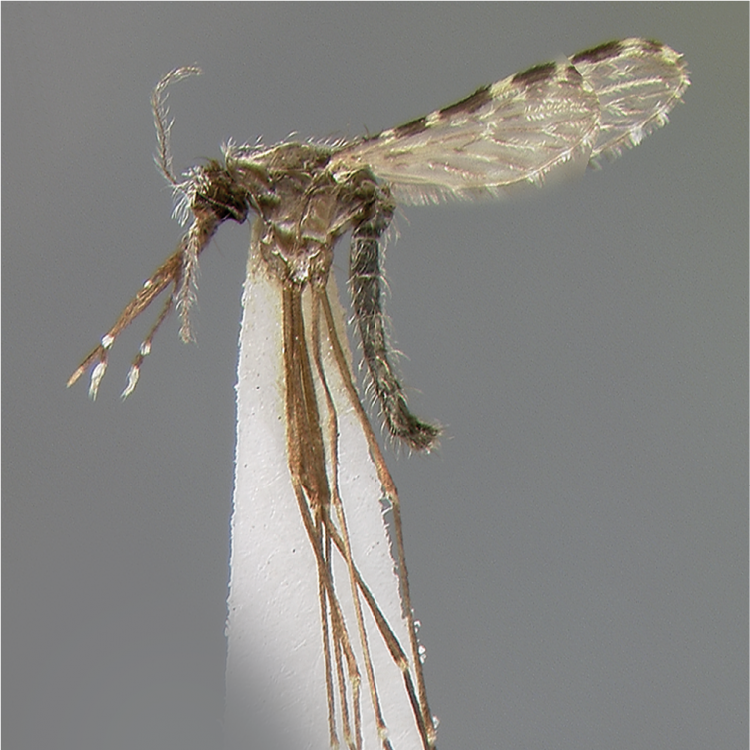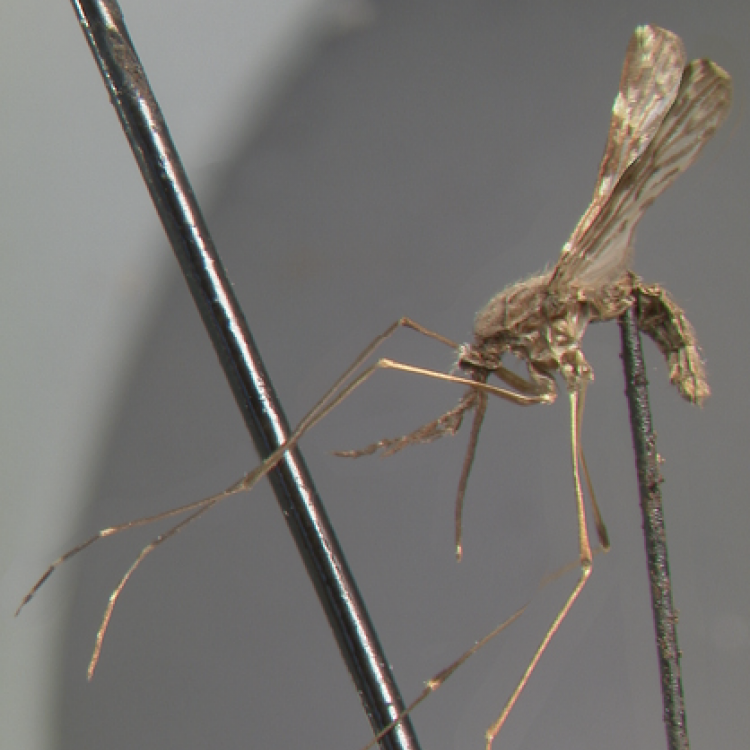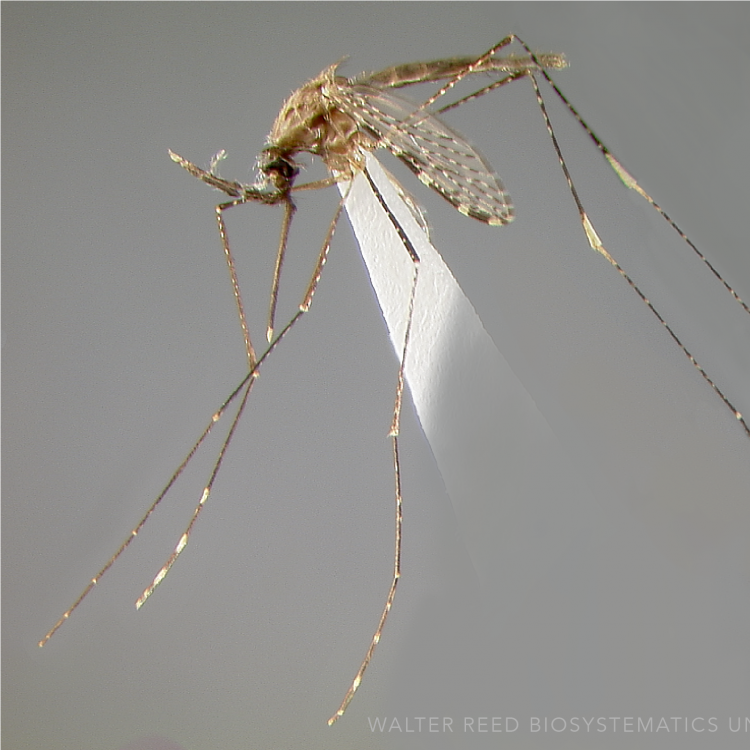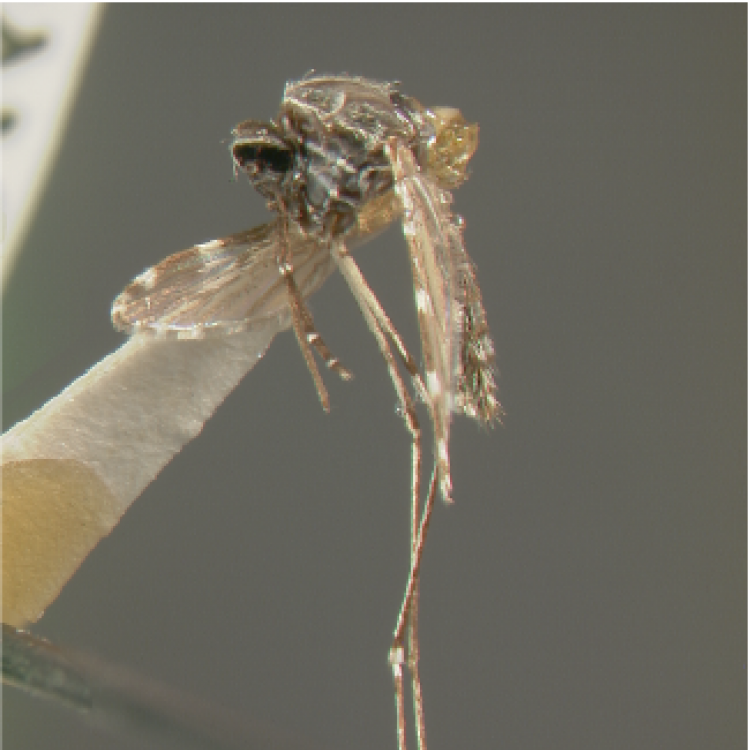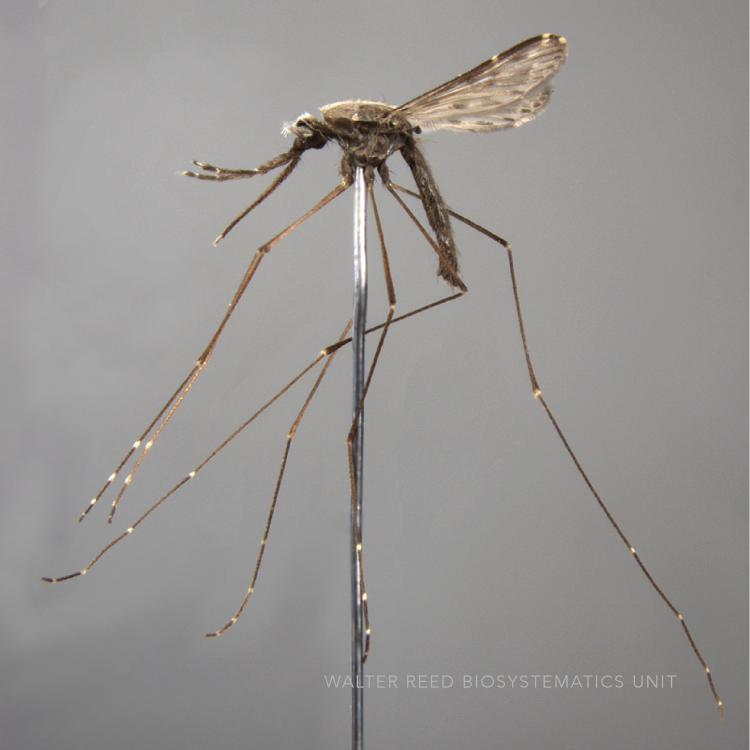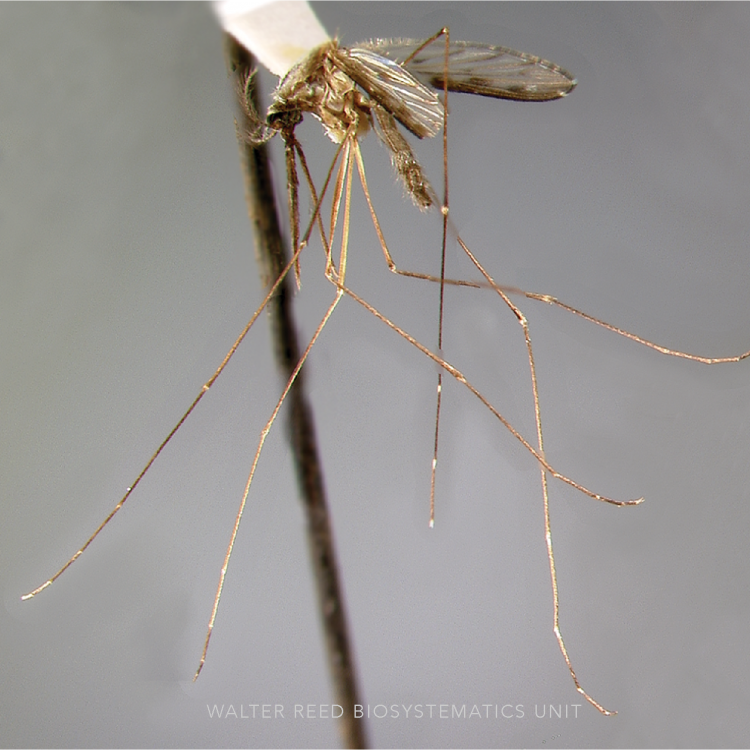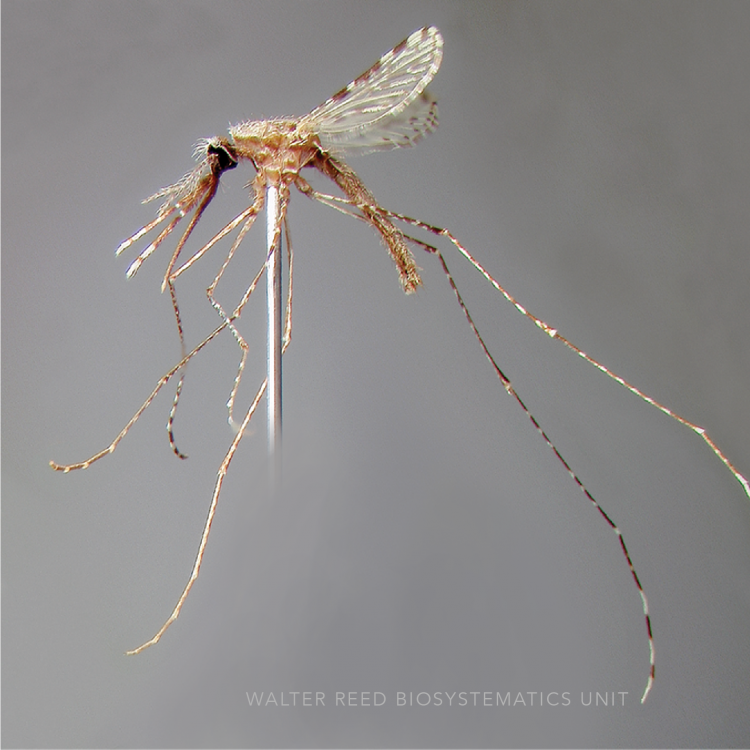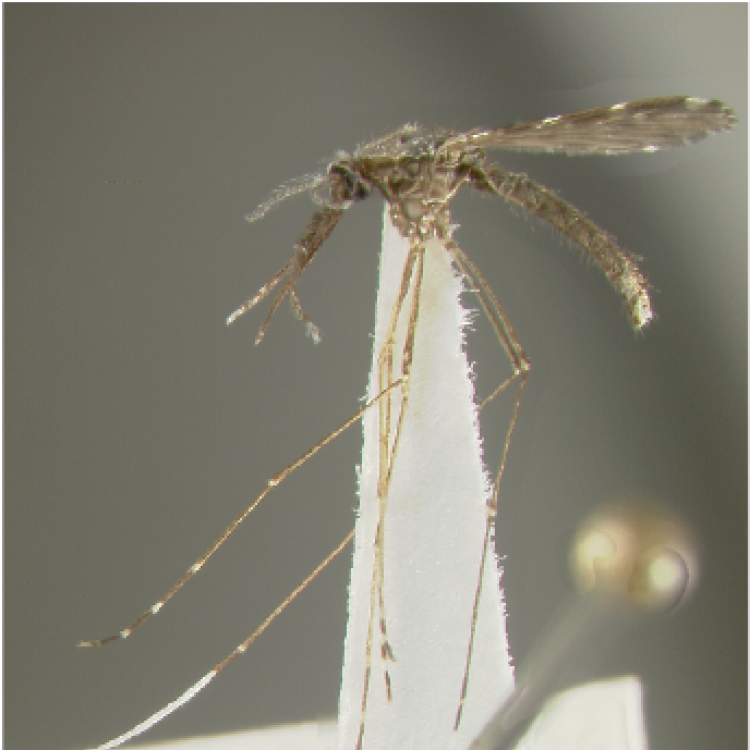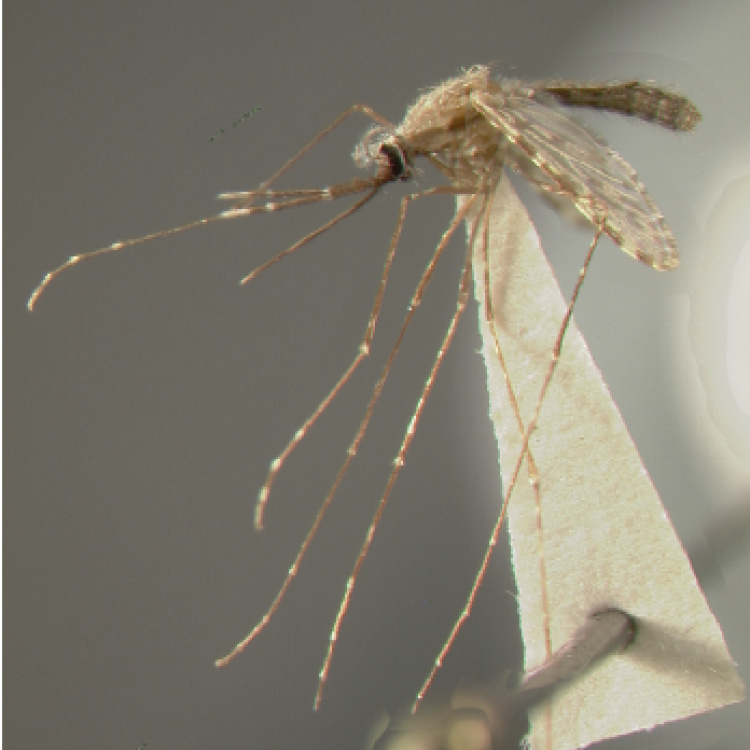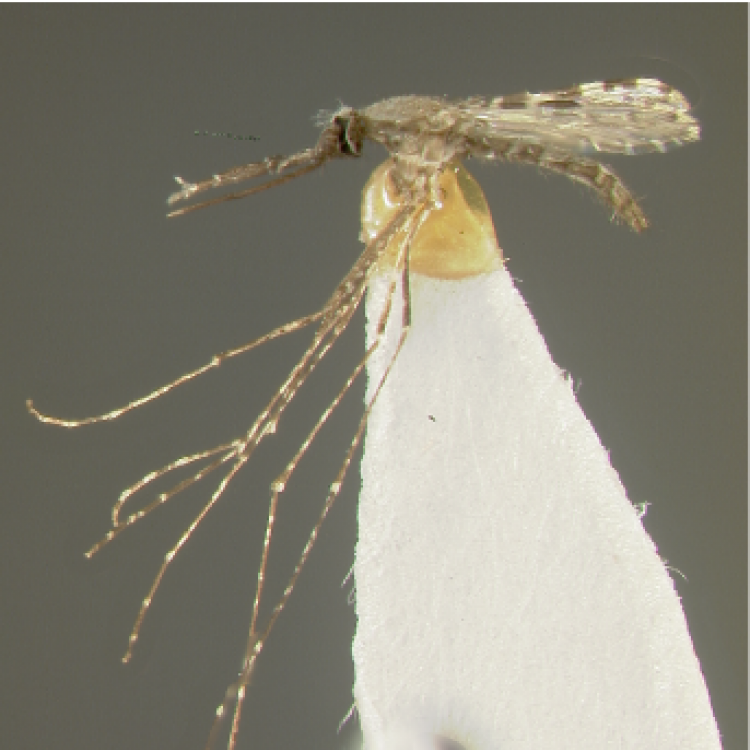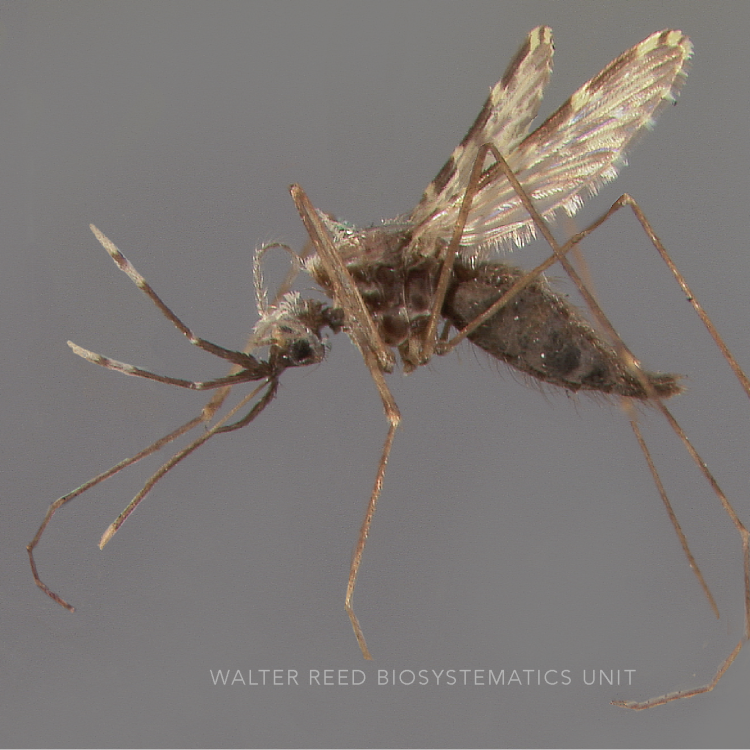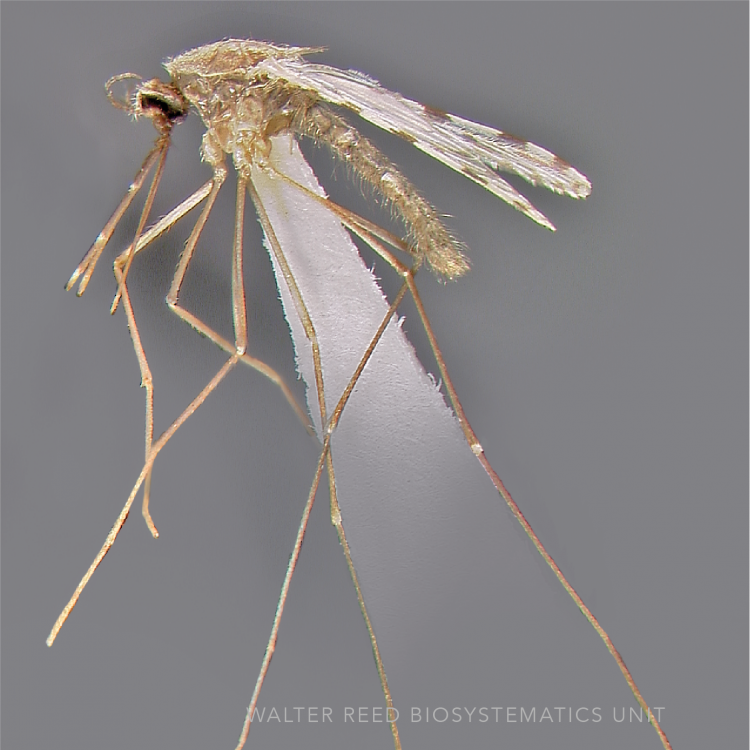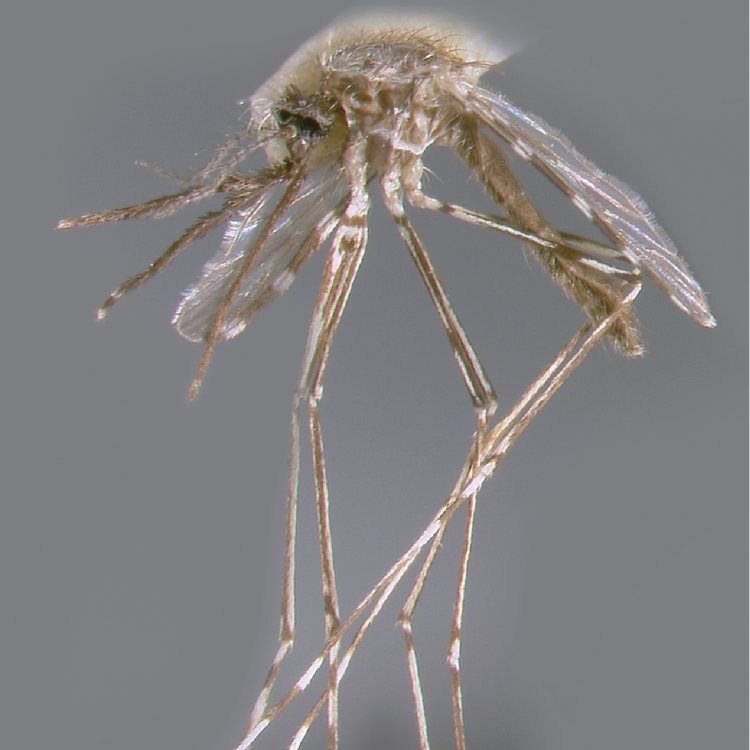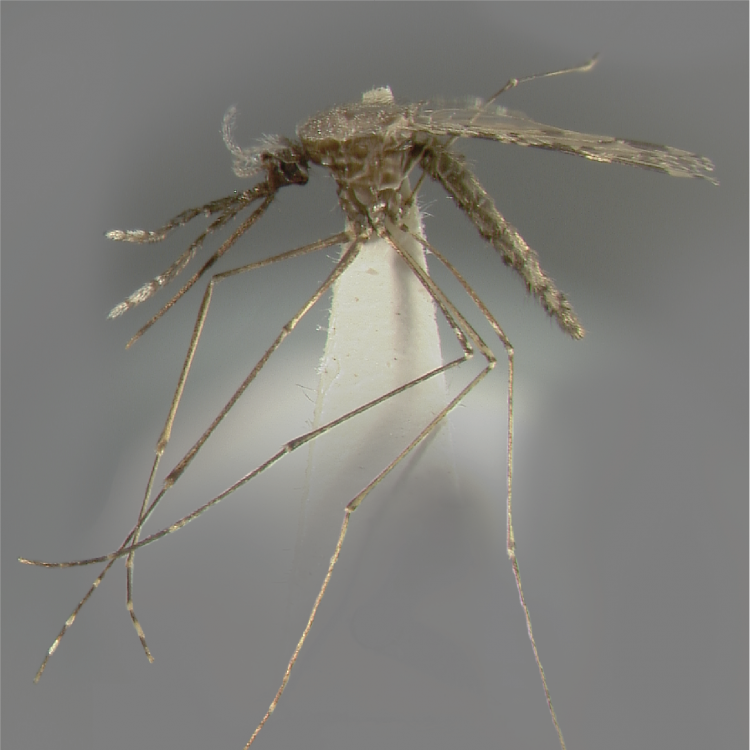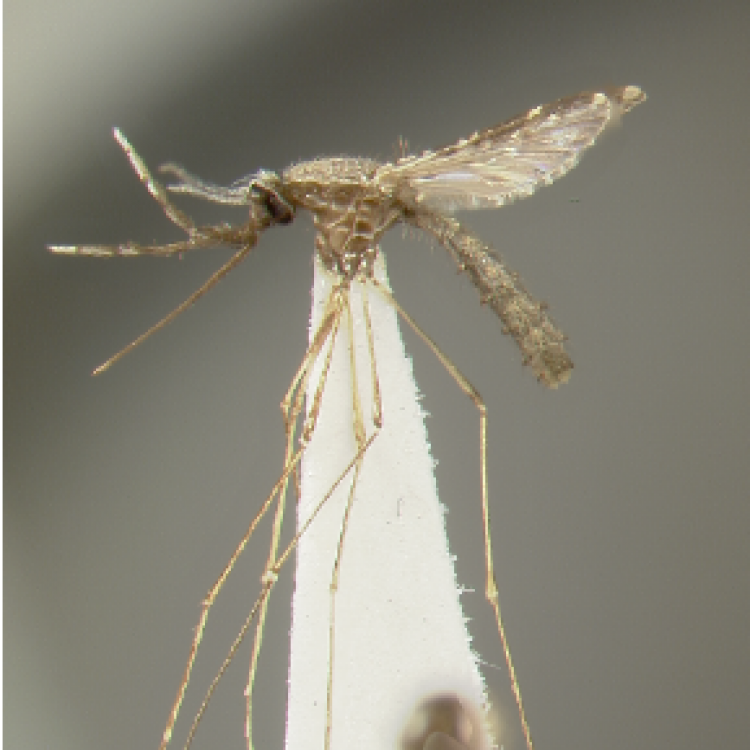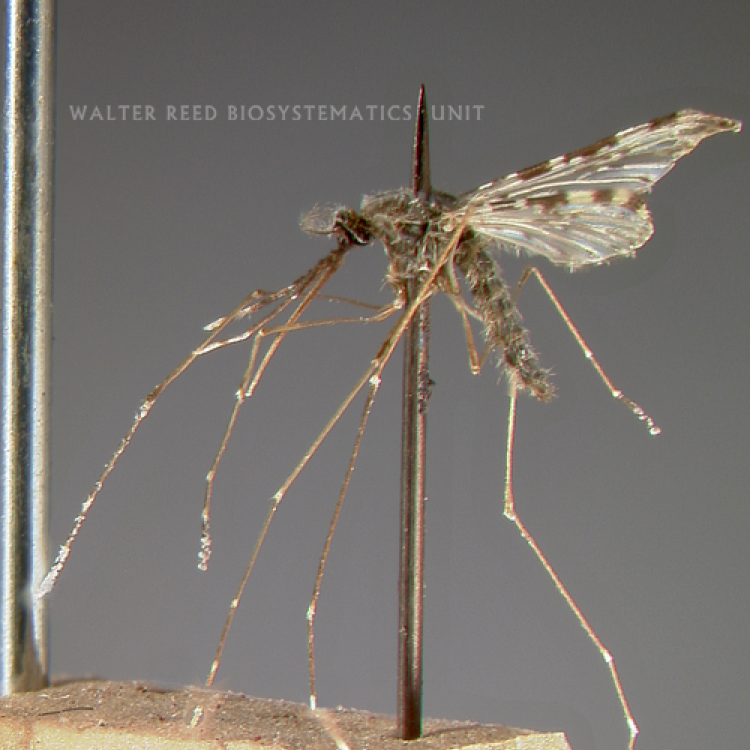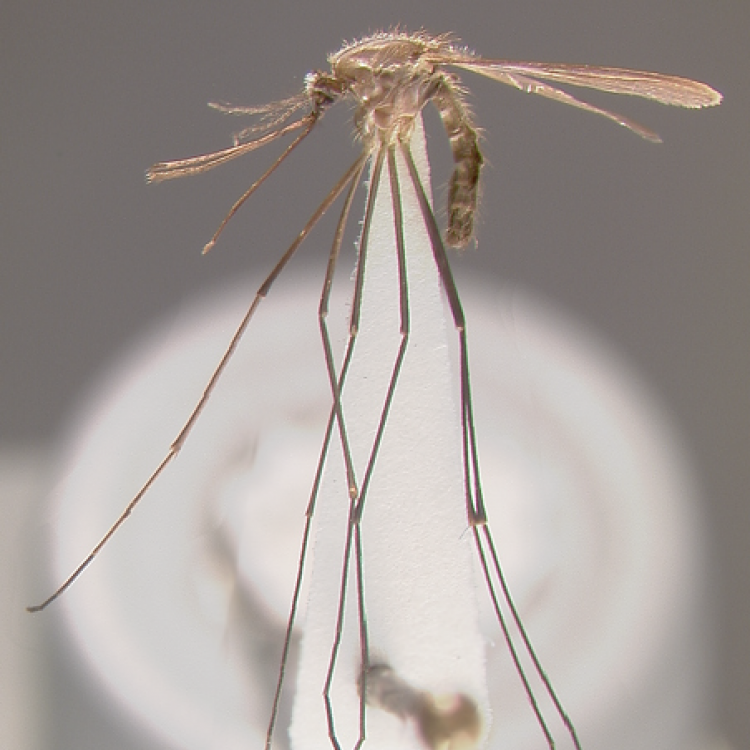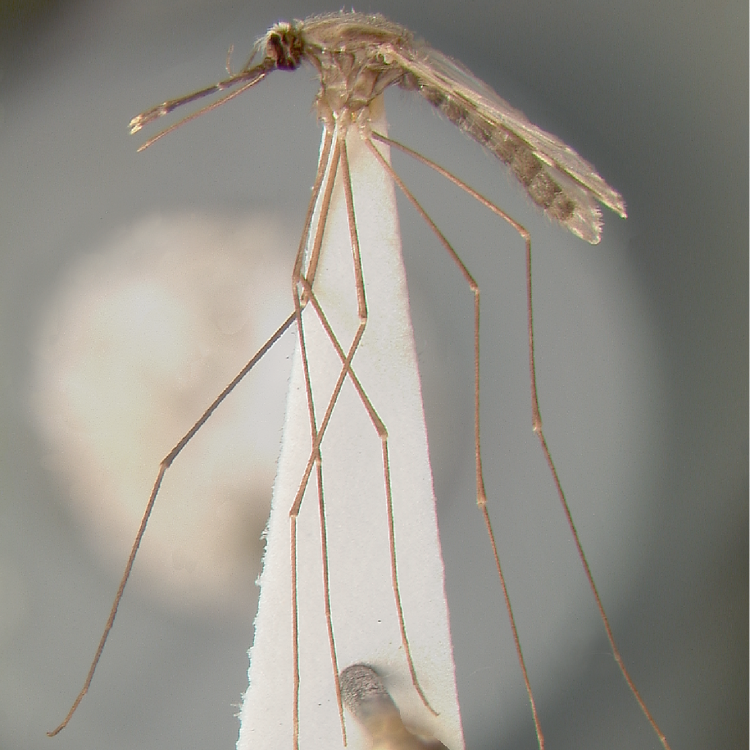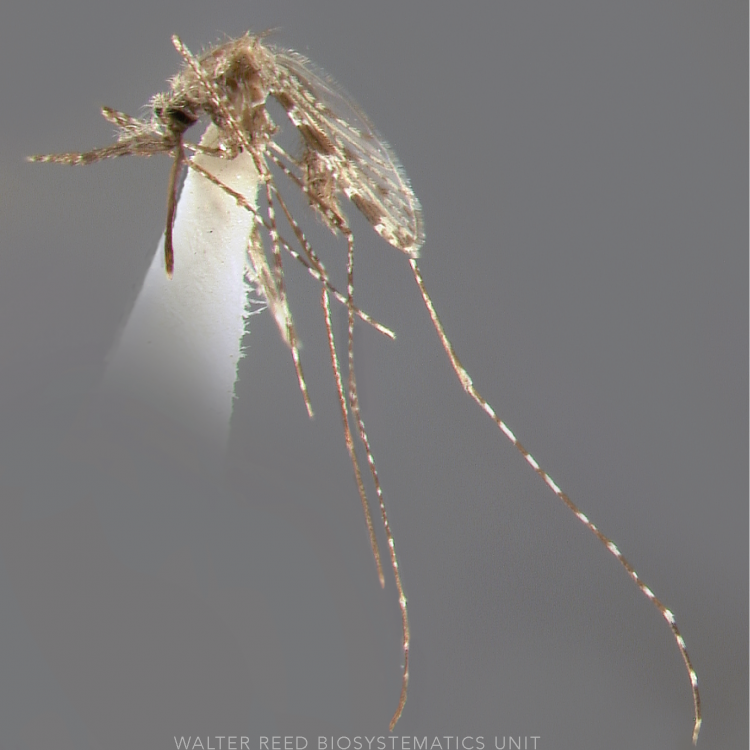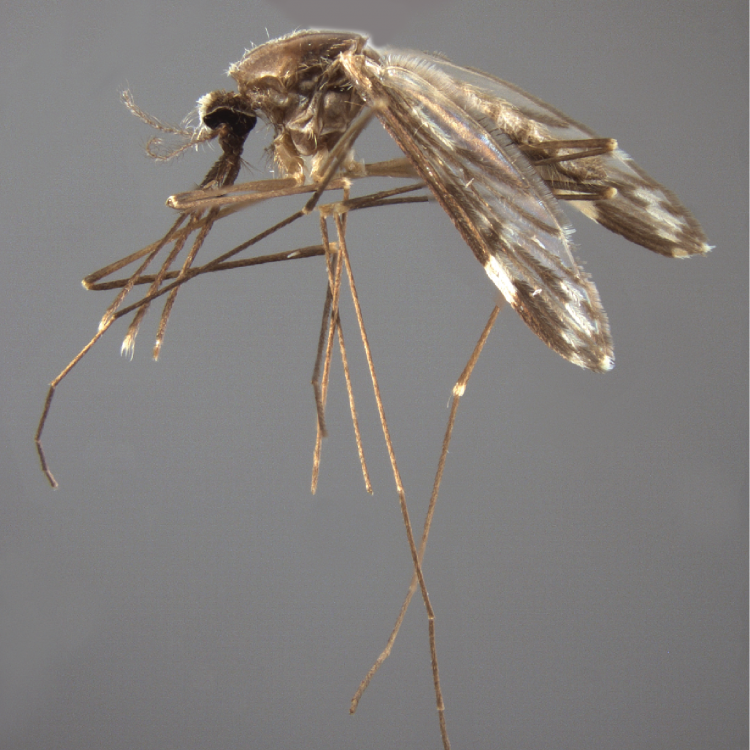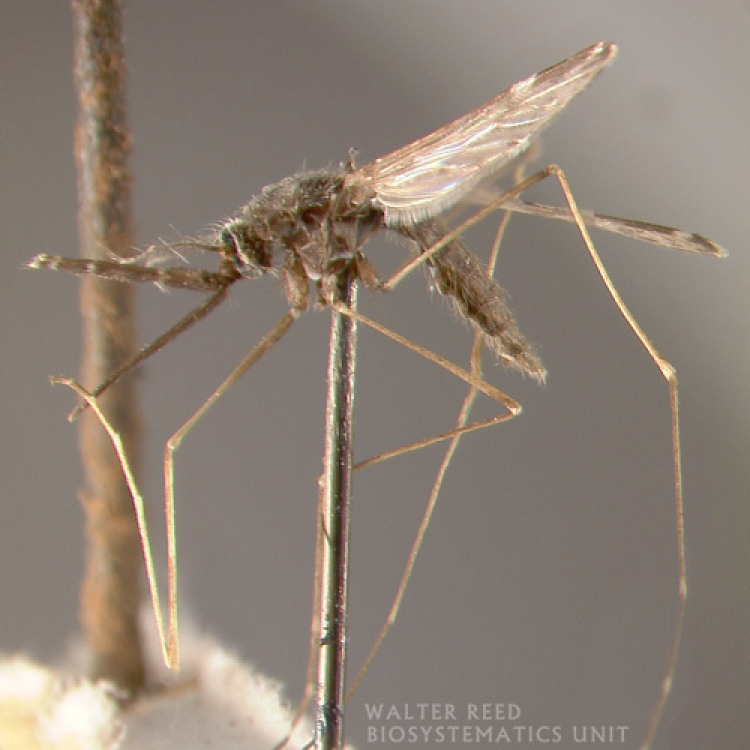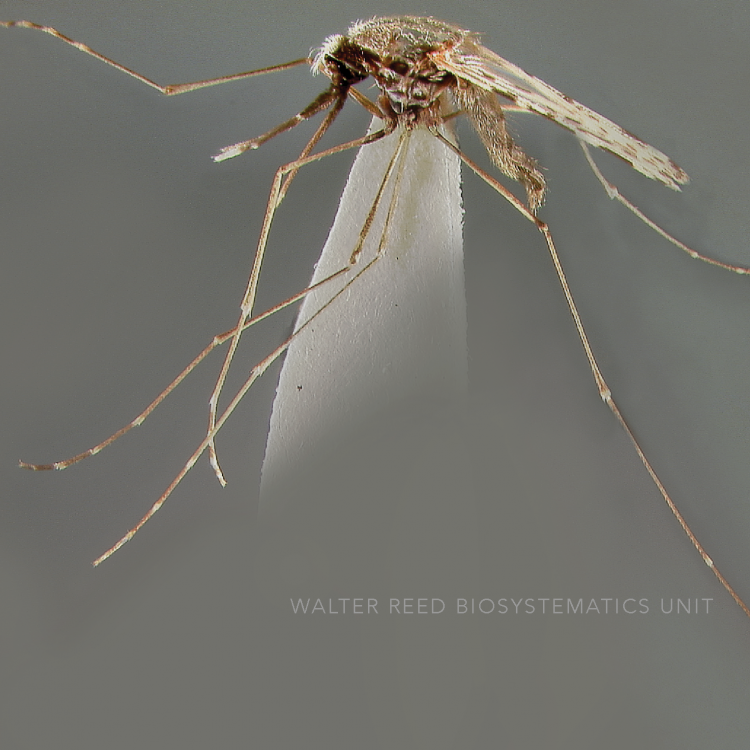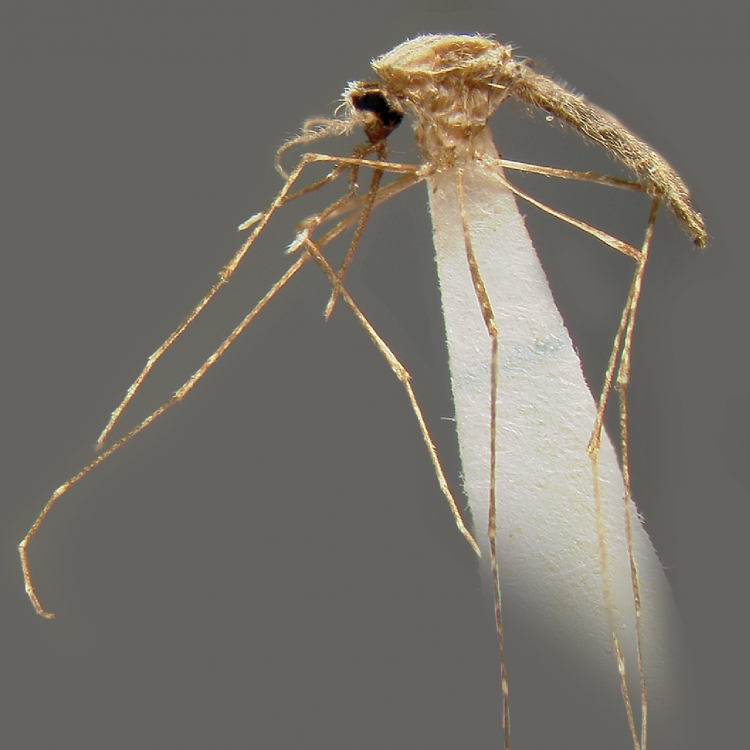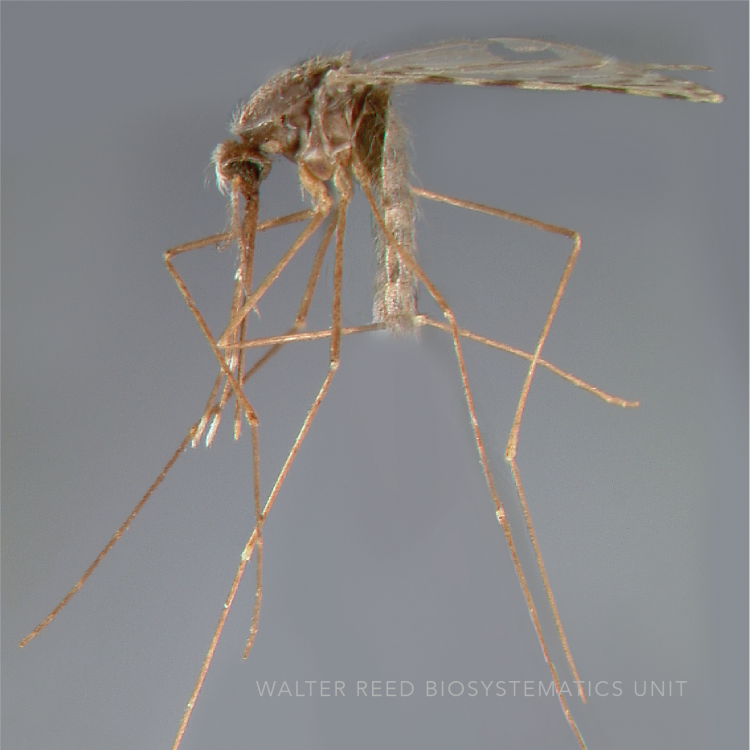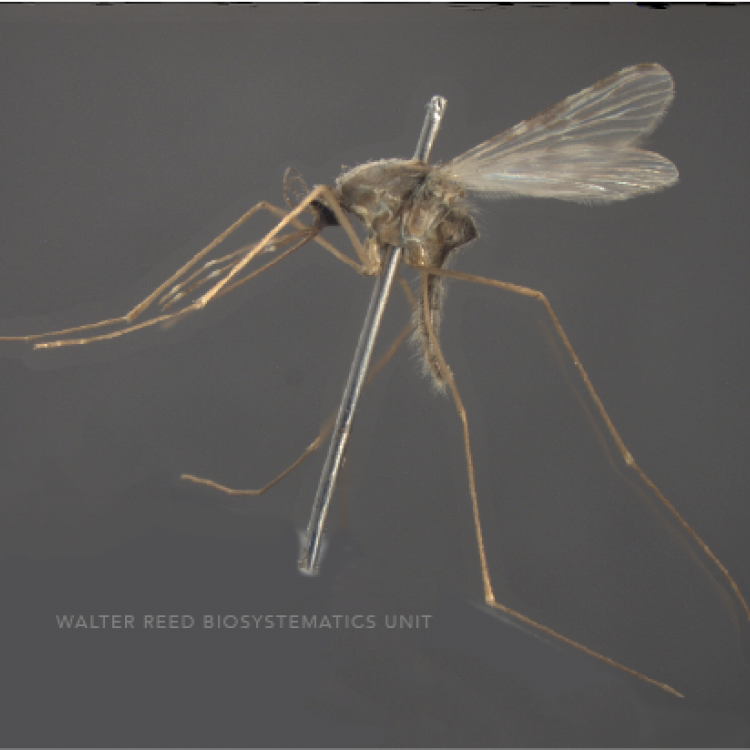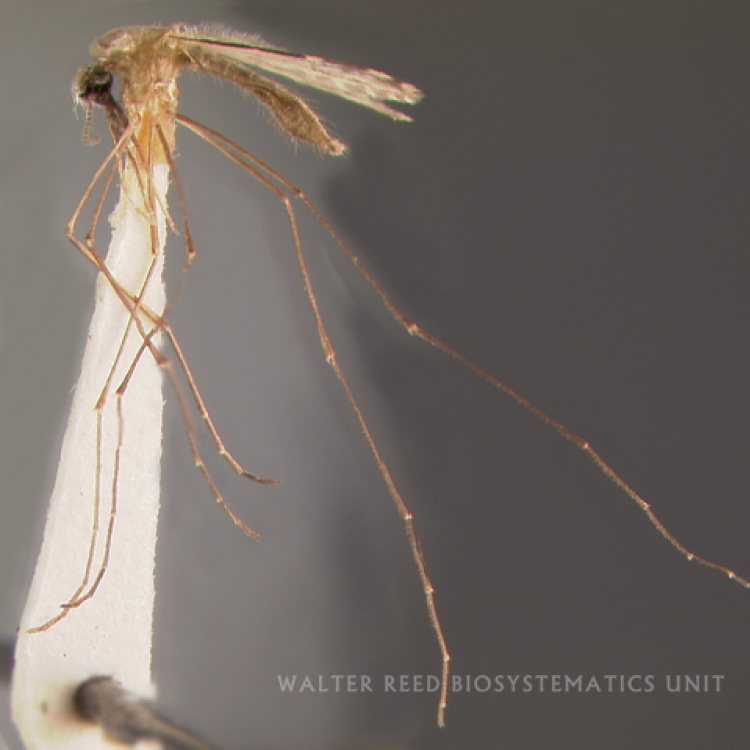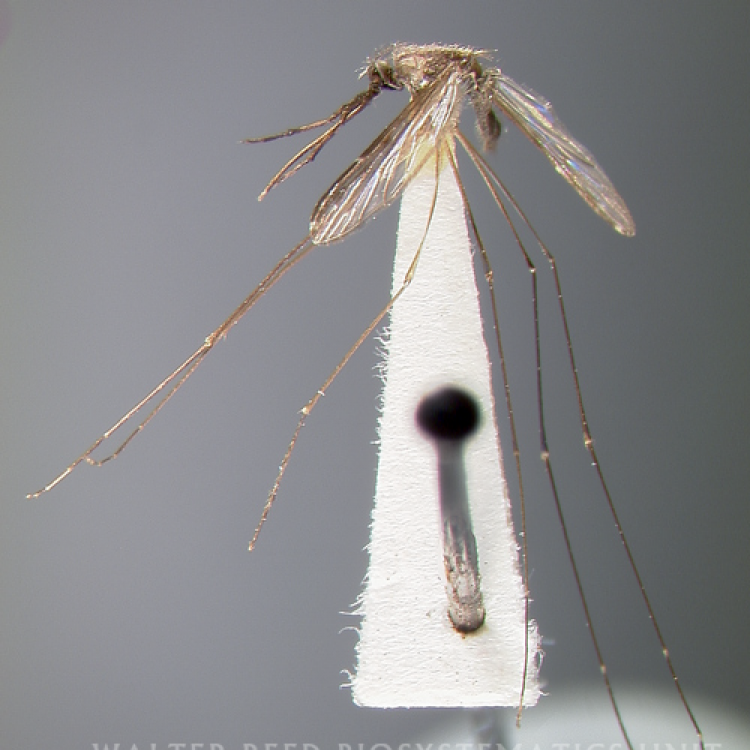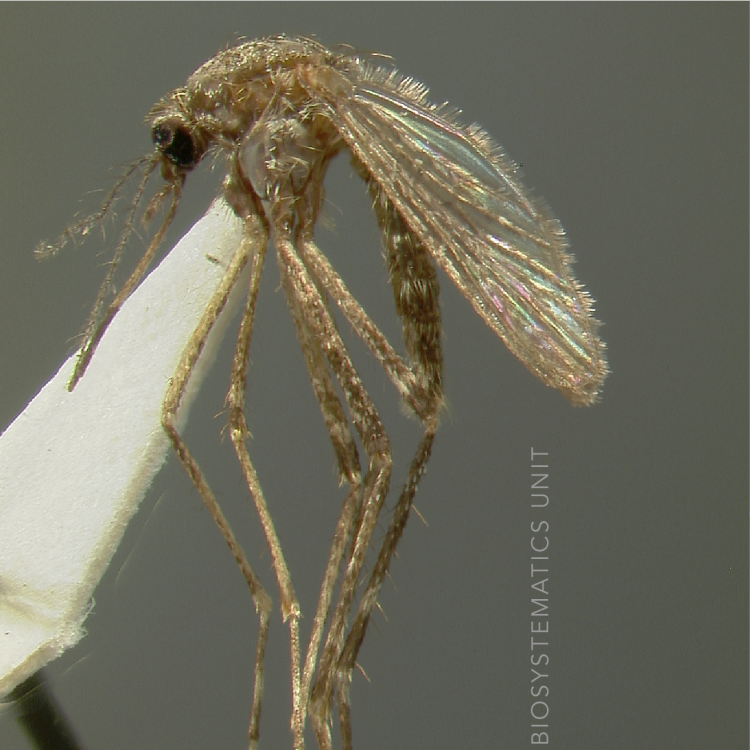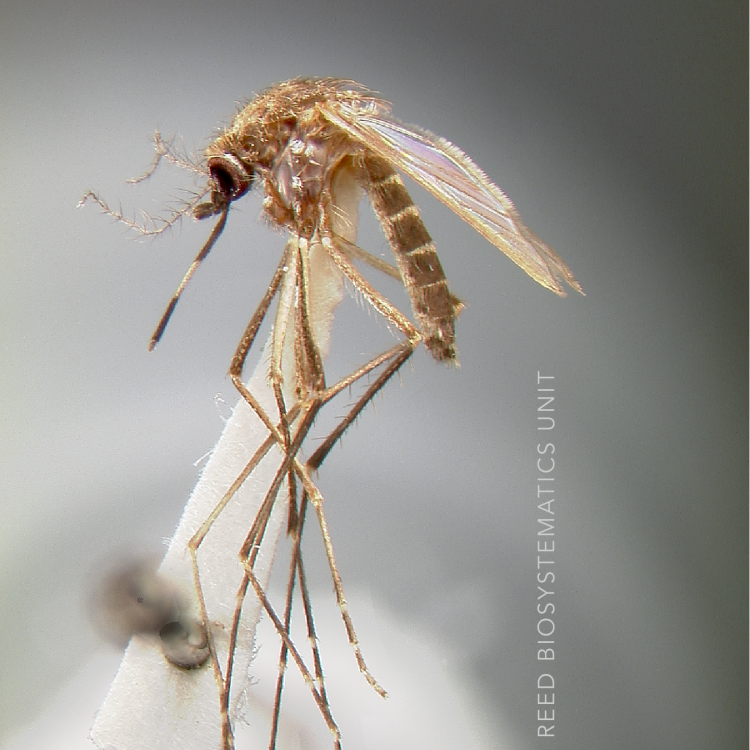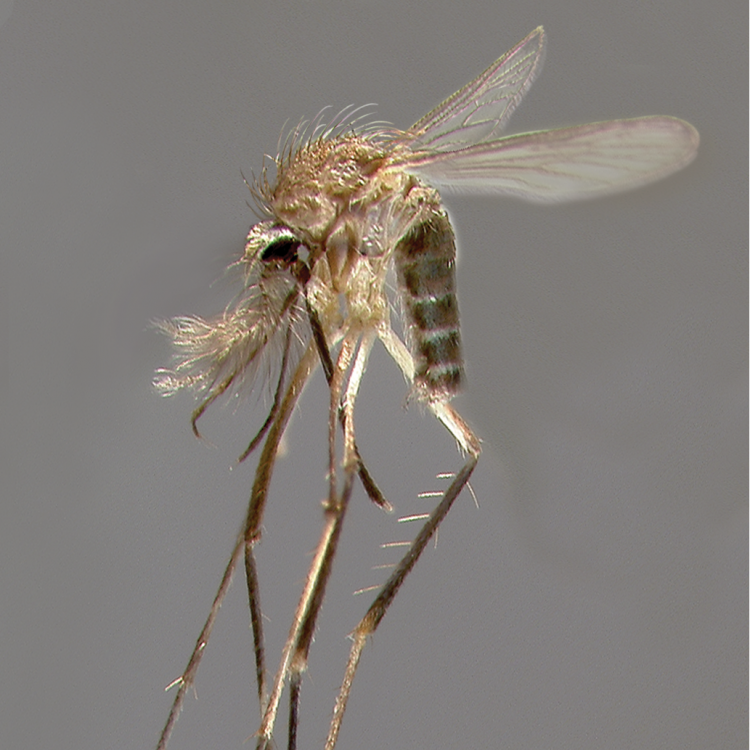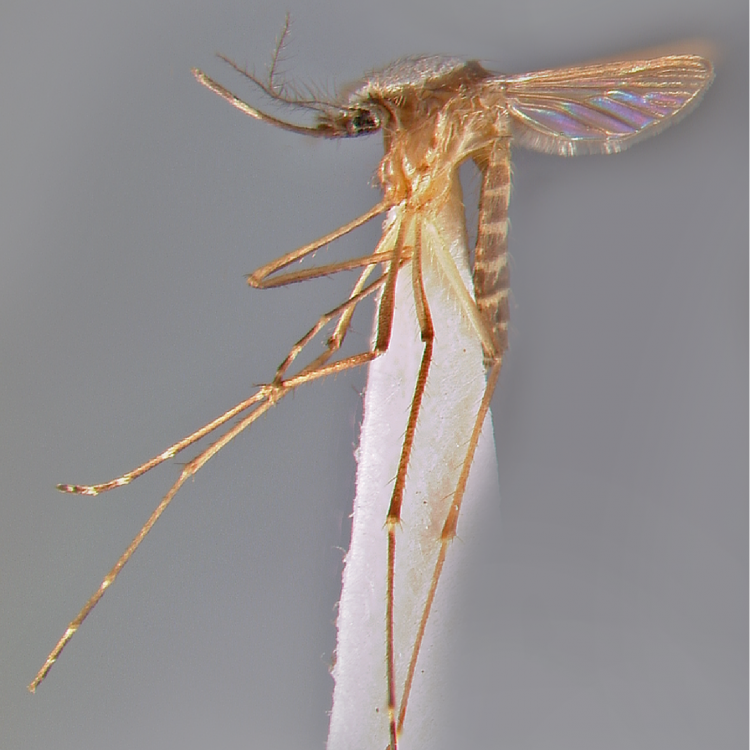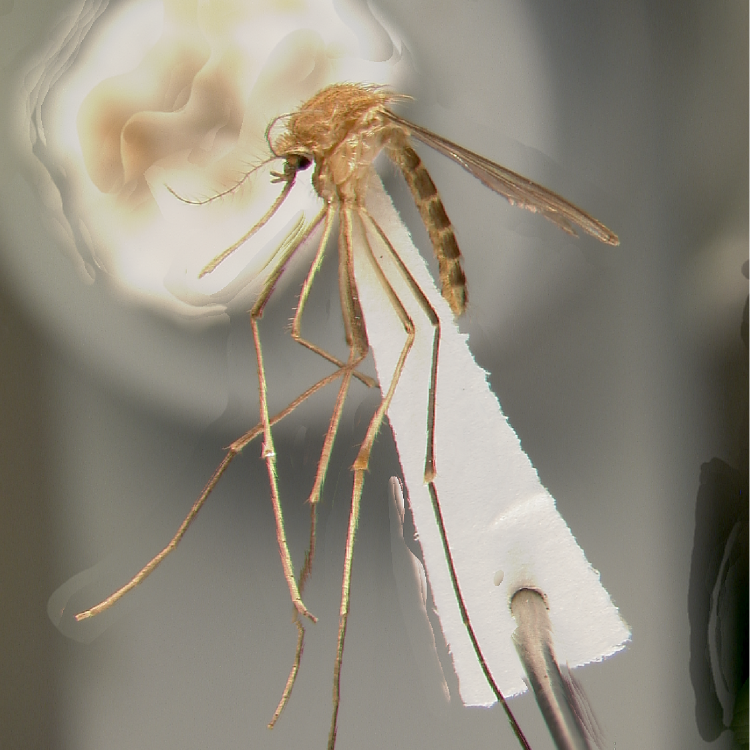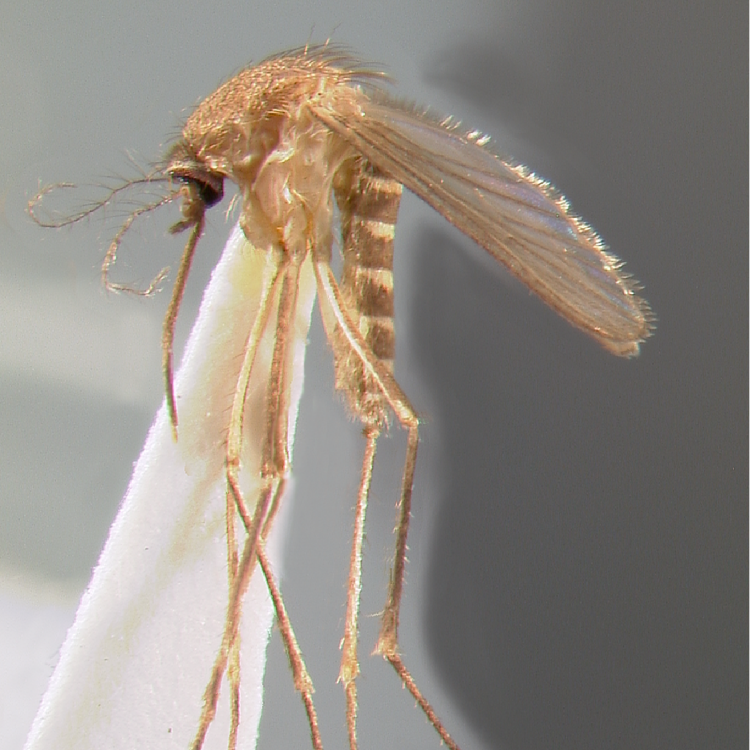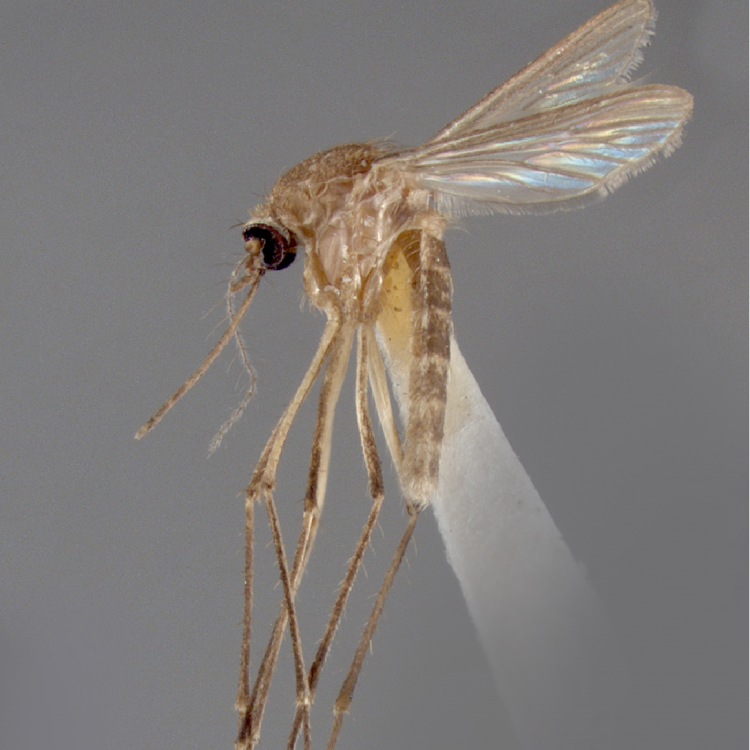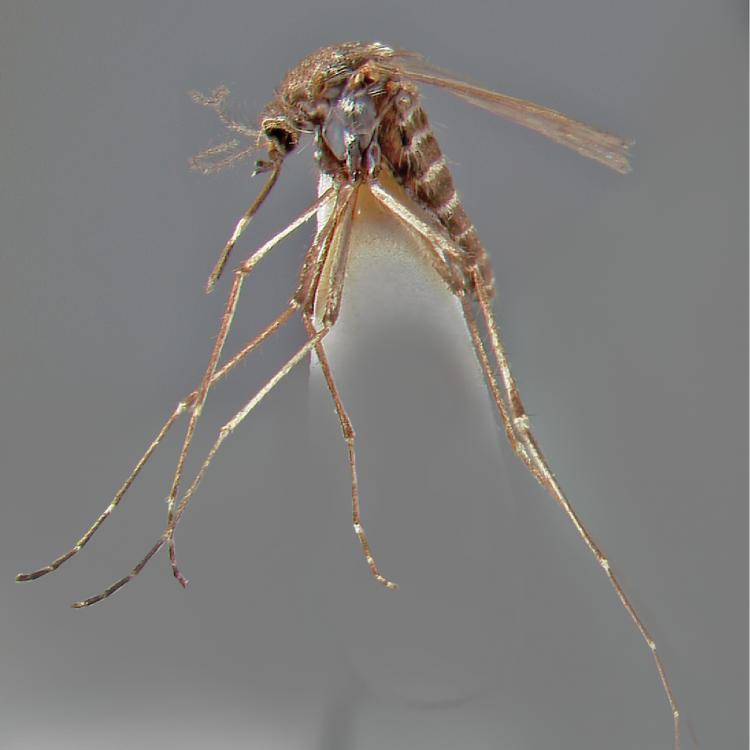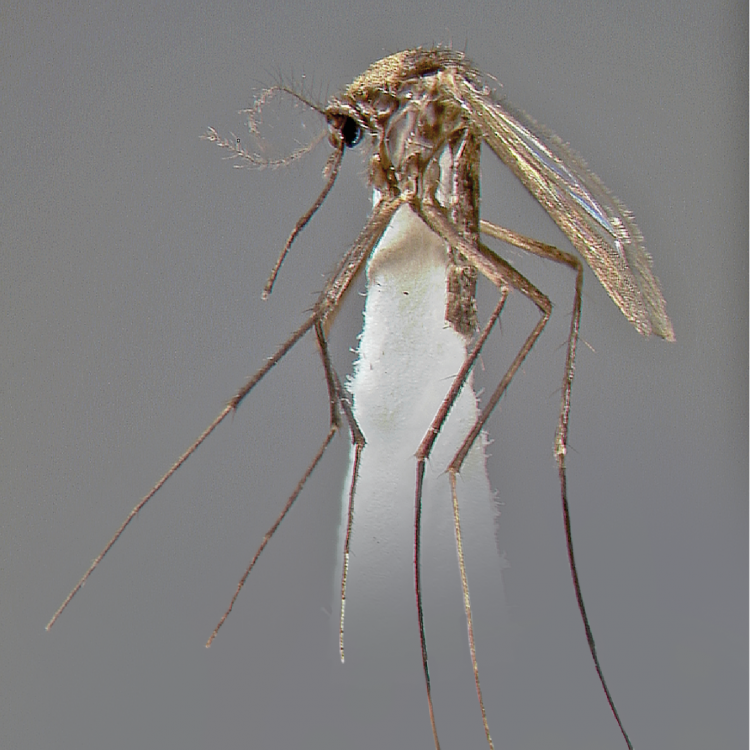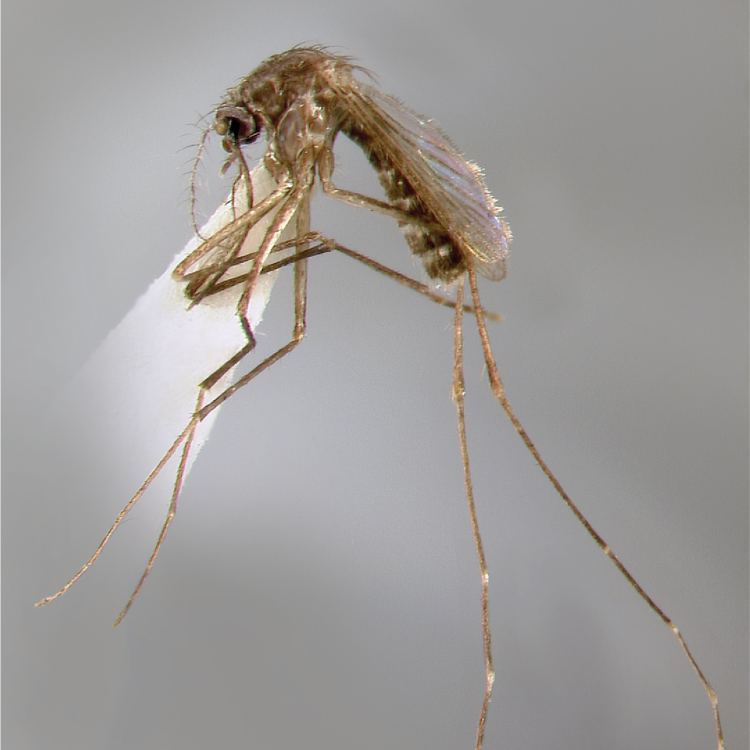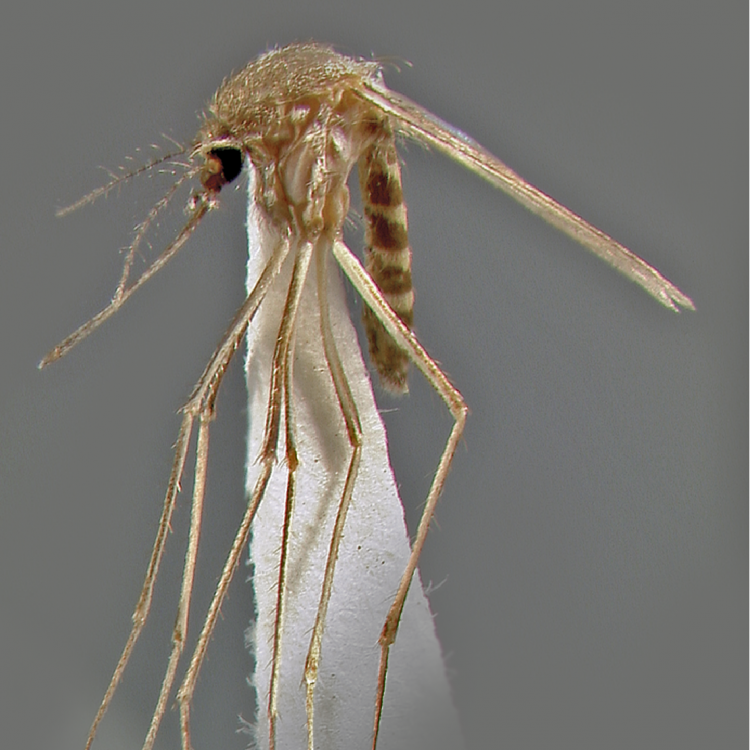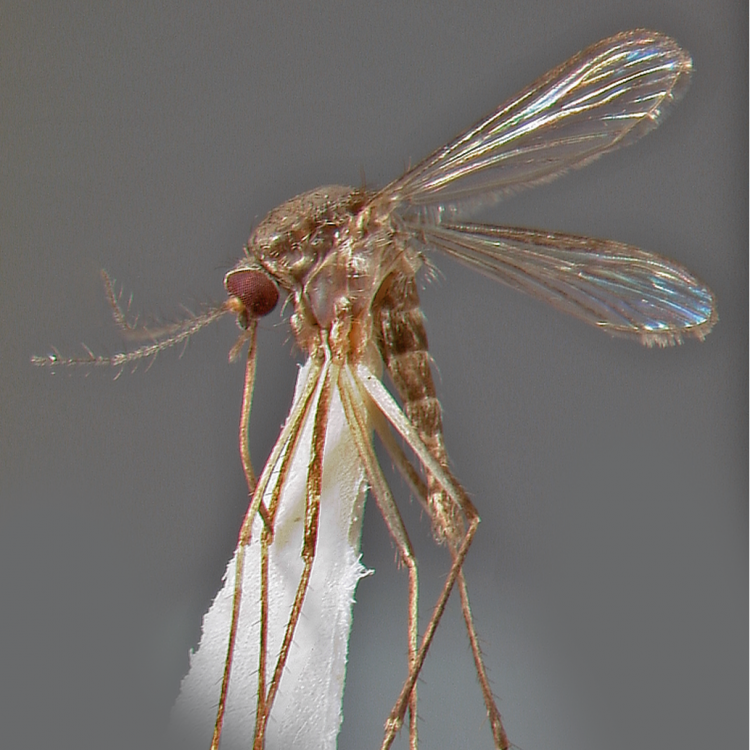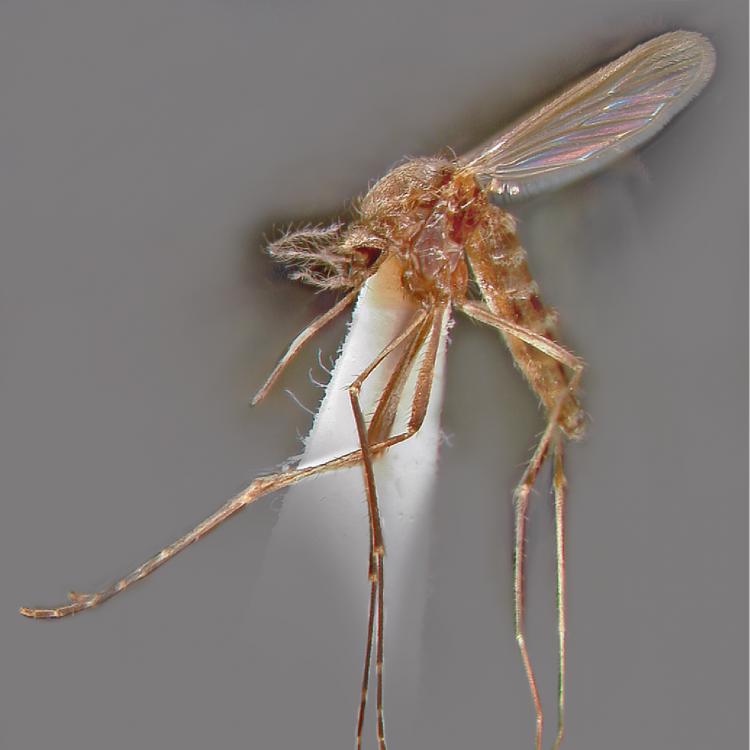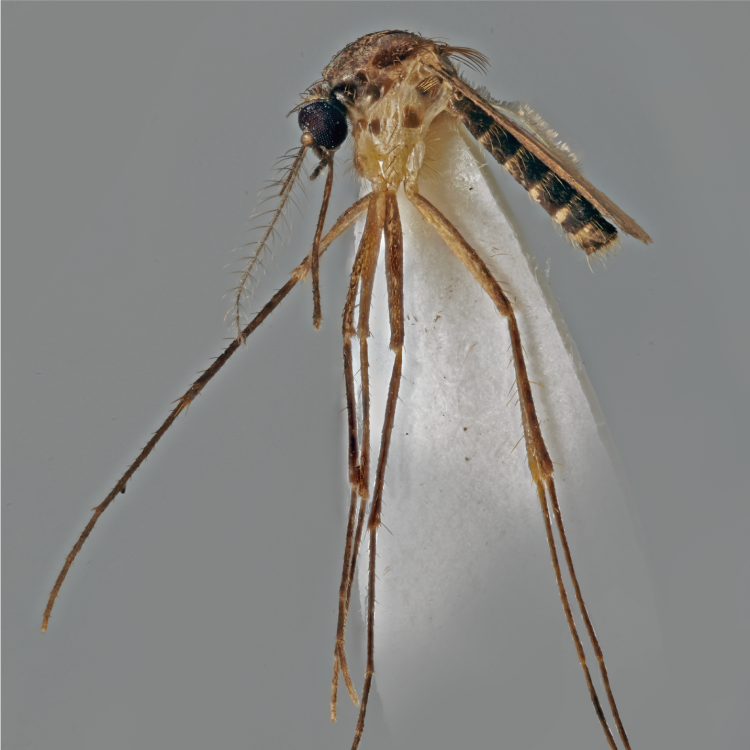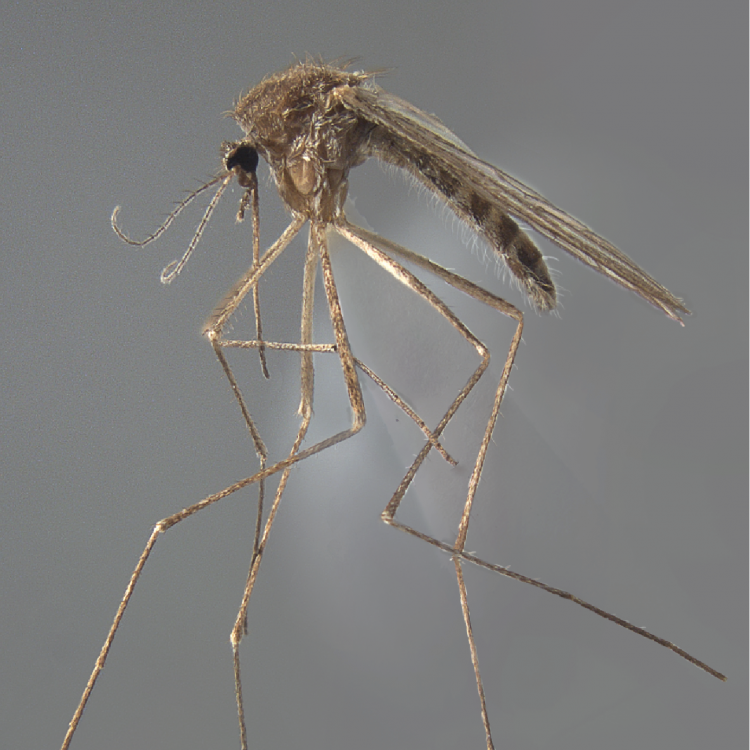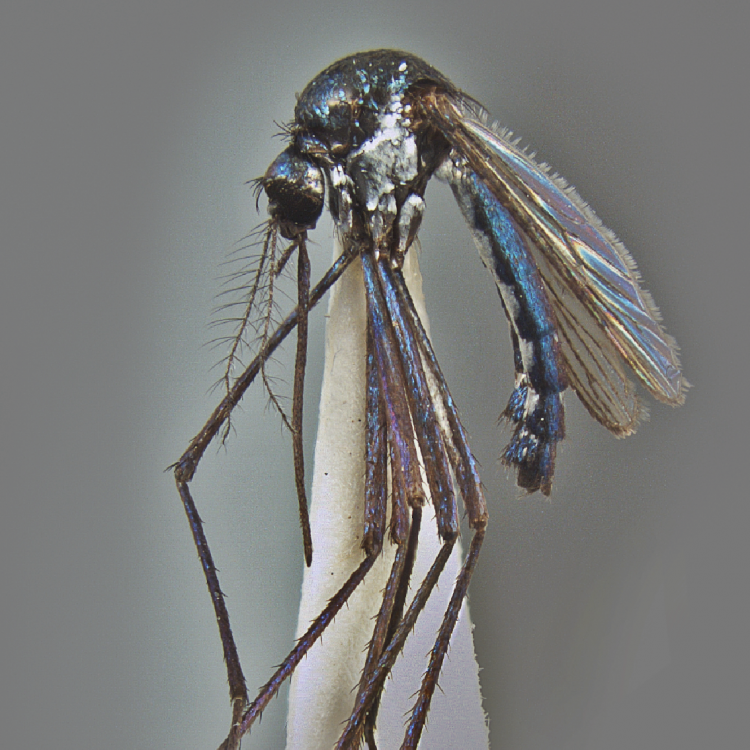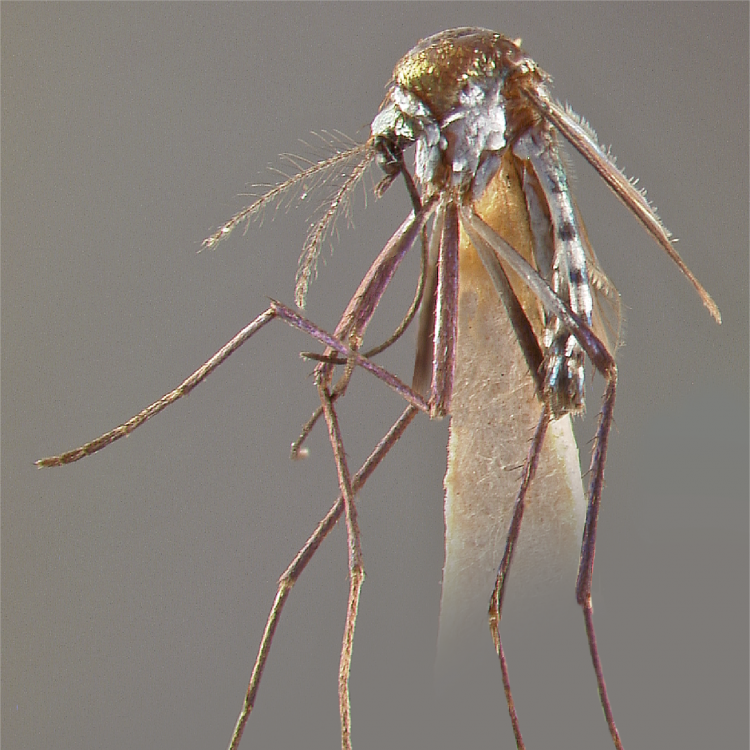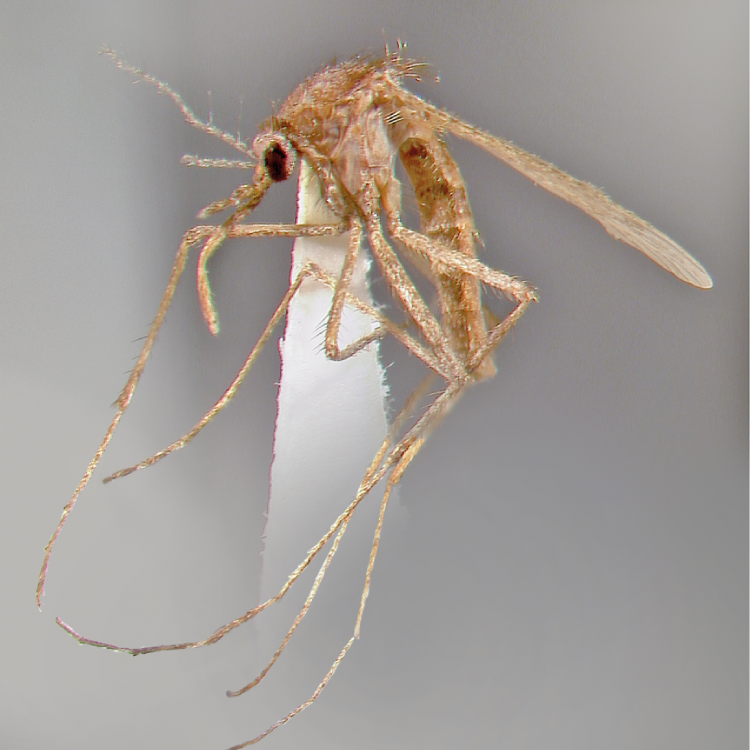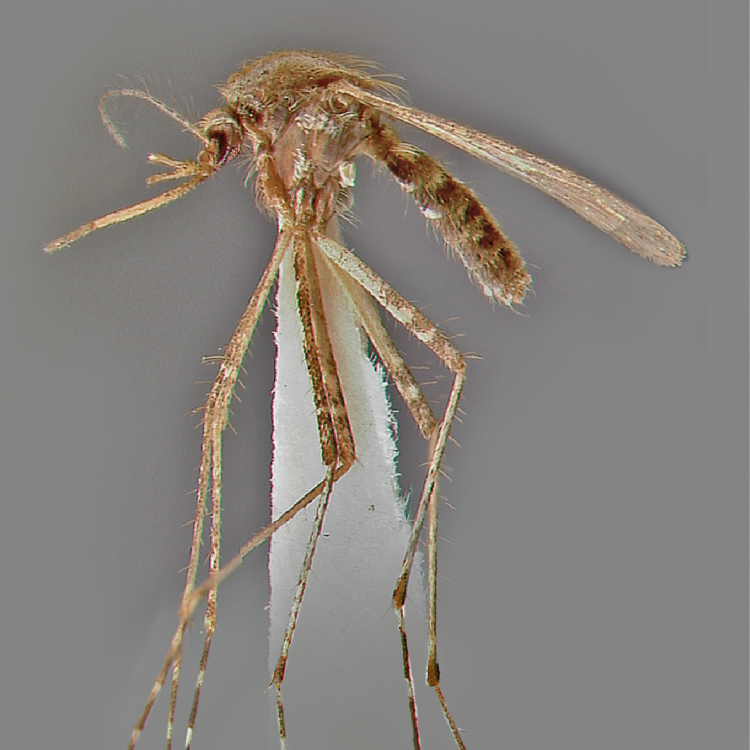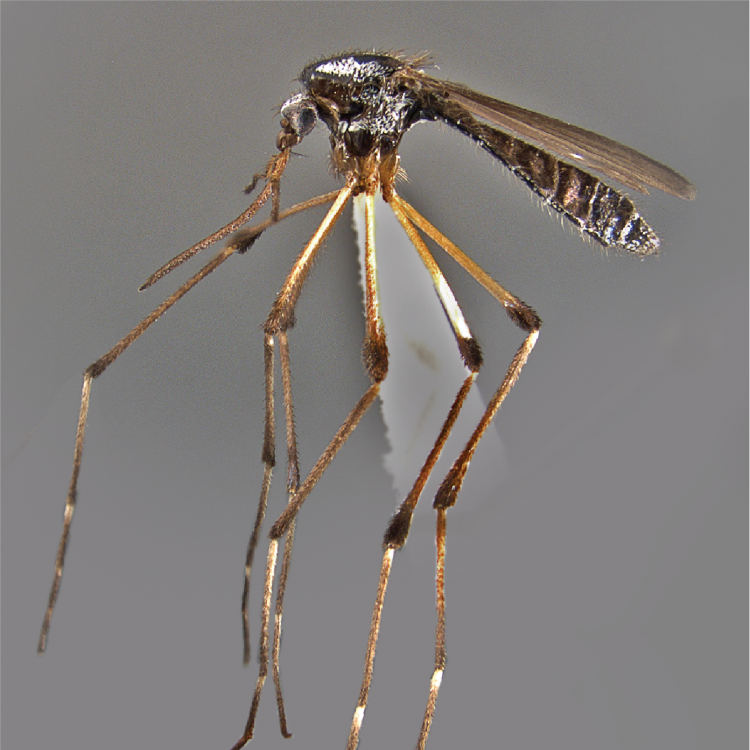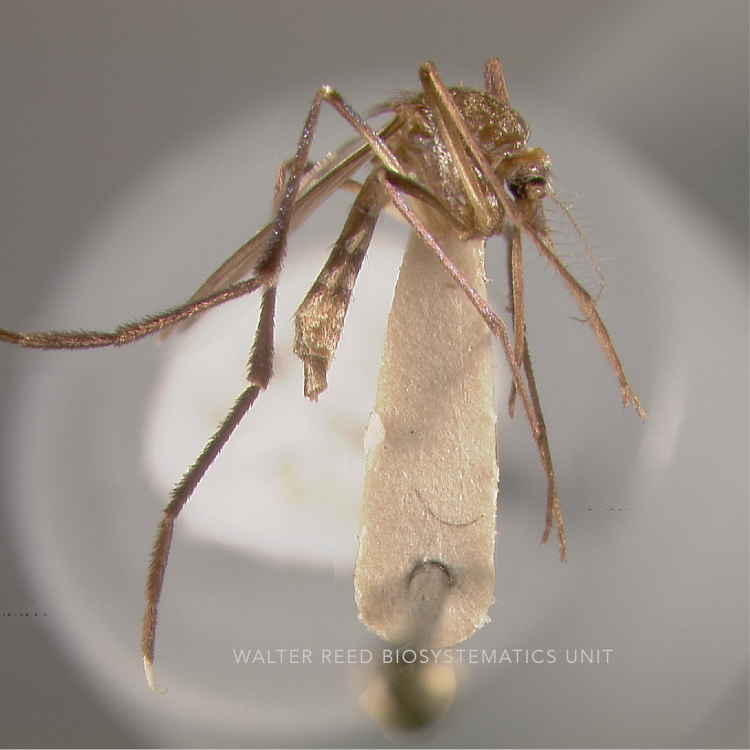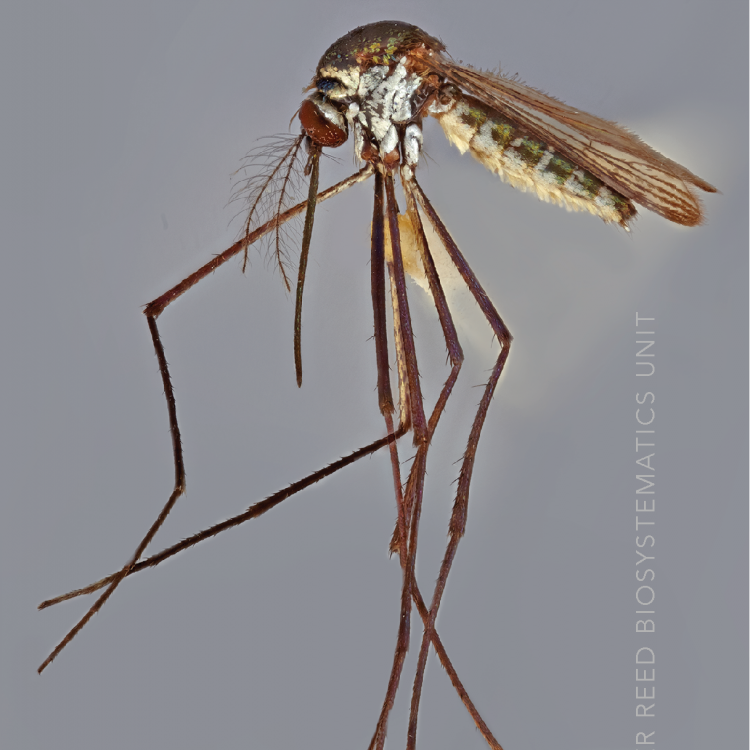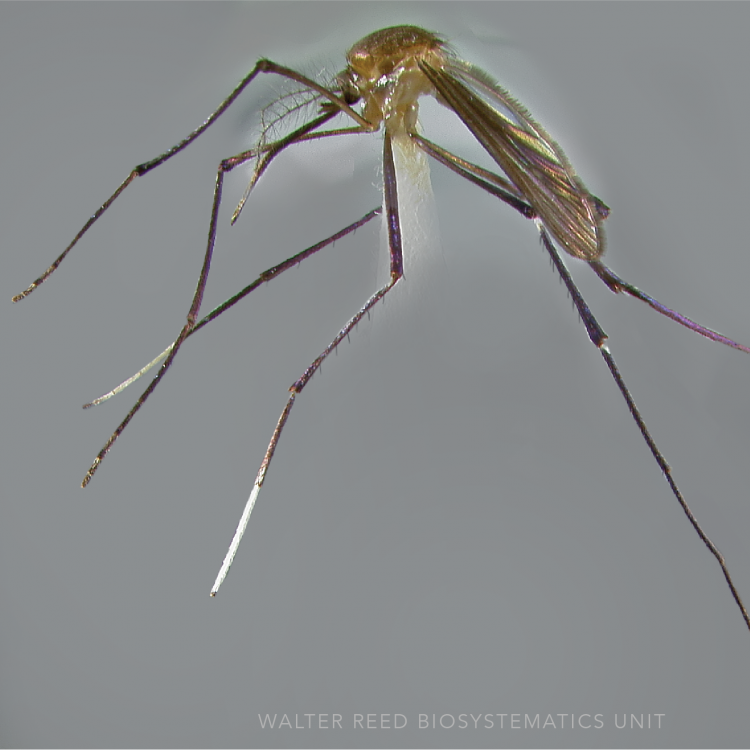PALEARCTIC REGION
Etymology: most beautiful (L)
Anopheles pulcherrimus is heavily dusted with white and golden scales, most notably on its scutum, head and antennae. It is an unplaced member of the Neocellia Series of Anopheles subgenus Cellia and has one valid synonym: atropotenae Lindtrop.
Type locality: Lahore, [Punjab, Pakistan]
Type depository: Natural History Museum, London, England, United Kingdom (NHMUK)
DIAGNOSTIC CHARACTERS (Click photos to view; mouse over and click large photo to zoom in.)
ADULT (illustrated): Head: Palpus with 4 pale bands. Wing: Leading edge of wing with 4 distinct dark areas. Legs: Ti-I–III and Fe-I–III with sparse pale scales; Fe-II,III with longitudinal white lines terminating in an oval spot; Ta-III2 with at least apical 0.5 pale; Ta-III3–5 all pale. Abdomen: Terga densely covered with broad pale scales; II–VII-Te with prominent posterolateral dark scale tufts.
LARVA (not illustrated): Head: Seta 3-C with 4–12 branches; seta 4-C at most half as long as 2,3-C. Thorax: Seta 1-P with many lateral branches arising from stout main stem. Abdominal segments: Tergal plates on segments III–VII somewhat reduced, with concave posterior border not subsuming small rounded posterior accessory tergal plate.
TAXONOMIC KEYS
Russell et al. 1943
Foote & Cook 1959
Glick 1992
![]()
WRBU - Anopheles - Afrotropical Region - Larva
![]()
WRBU - Anopheles - Western Palearctic Region - Adult
![]()
WRBU - Genera - Global - Adult
![]()
WRBU - Genera - Global - Larva
![]()
WRBU - Genera - Eastern Palearctic - Adult
![]()
WRBU - Genera - Eastern Palearctic - Larva
![]()
WRBU - Anopheles (Cel.) Neocellia Series - Oriental - Adult
![]()
WRBU - Anopheles (Cel.) Neocellia Series - Oriental - Larva
Exemplar DNA sequences
An. pulcherrimus COI: JX255709–JX255712
BIONOMICS
Immatures
Immature An. pulcherrimus are restricted to warm, sun-lit, stagnant habitats with abundant submerged vegetation—e.g., pools in river beds and floodland lakes. In warmer climates, shallow young rice fields are also productive larval habitats for this species.
Adults
Anopheles pulcherrimus is found in lowland river valleys in Uzbekistan and Tajikistan, at elevations ranging to 1000 m above sea level. Although they will also feed on cattle and have been collected resting in cattle sheds and pit shelters, females are highly anthropophilic, and prefer to feed outdoors. In Herat, Afghanistan, An. pulcherrimus populations peak in the latter half of July and throughout August. During the stifling summer heat in the Indian subcontinent, many people sleep outside and An. pulcherrimus numbers swell. In Tajikistan in the 1970s, An. pulcherrimus biting rates reached 110-120 every five minutes in the evening. In the Sistan and Baluchistan provinces of Iran, and in Iraq, An. pulcherrimus populations are bivoltine, with two peaks—May–June and Oct–November. However, no genetic differences were noted between the populations.
DISTRIBUTION NOTES
Afghanistan, Bahrain, India, Iran, Iraq, Israel (and Gaza Strip & West Bank), Kazakhstan, Lebanon, Pakistan, Russia, Saudi Arabia, Syria, Tajikistan, Kuwait, Turkey, Uzbekistan.

WRBU VECTOR HAZARD REPORTS
VHR: Medically Important Mosquitoes of EUCOM
View other WRBU Vector Hazard Reports
Available GIS Models:
None
IMPORTANT REFERENCES (full citations below)
Theobald 1902a: 369 (F*)
Christophers & Barraud 1931: 180 (E*)
Senevet 1931: 41 (P*)
Christophers 1933: 311 (M*, F*, P, L*, E)
Russell et al. 1943 (F, L; keys, bionomics)
Bates et al. 1949: 434 (bionomics)
Macan 1950 (bionomics)
Foote & Cook 1959 (key, bionomics)
Chinayev 1965 (bionomics, distribution; Central Asia)
Baker et al. 1968 (chromosomes)
Gokberk 1970: 20 (distribution)
Gutsevich et al. 1974: 110 (M*, F, L*)
Bulichev 1977 (bionomics)
Glick 1992 (F*; key, taxonomy, distribution)
Zaim et al. 1992 (bionomics)
Djadid et al. 2003 (molecular taxonomy)
Ahmed et al. 2011 (distribution; Saudi Arabia)
Robert et al. 2019 (distribution; western Palaearctic)
CURRENT SYNONYMS
syn. atropotenae Lindtrop
1924: 40 (A; Cellia; as var.). Type locality: Azerbaydzhan, USSR [Azerbaijan](LU).
CITED REFERENCES
Ahmed, A.M., Shaalan, E.A., Aboul-Soud, M.A.M., Tripet, F., & Al-Khedhairy, A.A. (2011). Mosquito vectors survey in the Al-Ahsaa district of eastern Saudi Arabia. Journal of Insect Science, 11, 176.
Bates, M., Beklemishev, W. N., & La Face, L. (1949). Anophelines of the Palearctic region. In M. F. Boyd (Ed.), Malariology: a comprehensive survey of all aspects of this group of diseases from a global standpoint, by 65 contributors (pp. 419–442). Philadelphia: W.B. Saunders Co.
Baker, R.H., Nasir, A.S., Aslamkhan, M. (1968). The salivary gland chromosomes of Anopheles pulcherrimus Theobald. Parassitologia, 10(2-3), 167-177 +5 plates.
Bulichev, V.P. (1977). Mosquito human attack activity at the virus foci of Tyagin in Tajikistan, In: Conference on “Theoretical Basis of Prophylaxis and Reduction of Infectious Diseases” pp. 90– 96. Leninobod [Khujand] , Tajikistan [in Russian].
Chinayev, P.P. (1965). Range and epidemiological importance of the malarial mosquitoes Anopheles maculipennis sacharovi Fv., A. superpictus Gr. and A. pulcherrimus Theob. (Diptera, Culicidae) in Soviet Central Asia. Entomological Review, 44(2), 164-169.
Christophers, S.R. (1933). The fauna of British India, including Ceylon and Burma. Diptera.Vol. IV. Family Culicidae. Tribe Anophelini. London: Taylor and Francis.
Christophers, S.R., & Barraud, P.J. (1931). The eggs of Indian Anopheles, with descriptions of the hitherto undescribed eggs of a number of species. Records of the Malaria Survey of India, 2(1), 161–192.
Djadid, N.D., Sanati, M.H., Zare, M., & Hassanzehi, A. (2003). rDNA-ITS2 identification of Anopheles pulcherrimus (Diptera: Culicidae): genetic differences and phylogenetic relation with other Iranian vectors and its implications for malaria control. Iranian Biomedical Journal, 7(1), 1–6.
Foote, R.H., & Cook, D.R. (1959). Mosquitoes of medical importance. Agricultural Handbook, U.S. Department of Agriculture, 152, 1–158.
Glick, J.I. (1992). Illustrated key to the female Anopheles of southwestern Asia and Egypt (Diptera: Culicidae). Mosquito Systematics, 24(2), 125–153.
Gokberk, C. (1970). The first record of A. pulcherrimus Theobald 1902 in Turkey. Its morphology, ecology and distribution. Turk Hifzissihha Tecrube Bioloji Dergisi, 30, 20–27.
Gutsevich, A.V., Monchadskii, A.S., & Shtakel’berg, A.A. (1974). Fauna of the USSR. New series No. 100 Diptera. Vol. III, No. 4. Mosquitoes. Family Culicidae. Jerusalem, Israel: Keter Publishing House Jerusalem Ltd. (Original work published 1971).
Lindtrop, G.T. (1924). [The white malaria mosquito A. pulcherrimus in Azerbaijan.]. Russian Journal of Tropical Medicine, 3, 38–40.
Macan, T.T. (1950). The Anopheline mosquitoes of Iraq and north Persia. London School Hygiene Tropical Medi Research Memorandum No 7. London: H.K & Lewis Co Ltd.
Robert, V., Günay, F., Le Goff, G., Boussès, P., Sulesco, T., Khalin, A., Medlock, J.M., Kampen, H., Petrić, D. & F. Schaffner. (2019). Distribution chart for Euro-Mediterranean mosquitoes (western Palaearctic region). Journal of the European Mosquito Control Association, 37, 1–28.
Russell, P.F., Rozeboom, L.E., & Stone, A. (1943). Keys to the anopheline mosquitoes of the world with notes on their identification, distribution, biology, and relation to malaria. Philadelphia: The American Entomological Society, the Academy of Natural Sciences.
Senevet, G. (1931). Contribution à l'étude des nymphes d'anophelines (2e Memoire). Archives de l'Institut Pasteur d'Algérie, 9, 17–112.
Theobald, F.V. (1902a). A short description of the Culicidae of India, with descriptions of new species of Anopheles. Proceedings of the Royal Entomological Society (B), 69, 367–394.
Zaim, M., Subbarao, S.K., Manouchehri, A.V., & Cochrane, A.H. (1993) Role of Anopheles culicifacies s.l. and An. pulcherrimus in malaria transmission in Ghassreghand (Baluchistan), Iran. Journal of the American Mosquito Control Association, 9(1), 23–26.
CITE THIS PAGE
Walter Reed Biosystematics Unit (Year). Anopheles pulcherrimus species page. Walter Reed Biosystematics Unit Website, http://wrbu.si.edu/vectorspecies/mosquitoes/pulcherrimus, accessed on [date (e.g. 03 February 2020) when you last viewed the site].



